








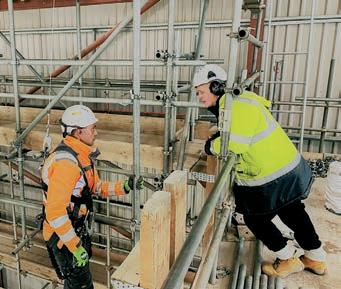






[WHILE THE COUNTRY is wallowing in a collective Slough of Despond over the cost of living (I’m old enough to remember 20% inflation and paid 15% pa interest on my first mortgage!) and the price of energy (ditto the oil crisis of 1973-4), there is a clutch of good news stories for the construction industry.
The latest figures from Glenigan on major projects – those over £100m – show a sector in rude health. The data analysis firm points to a list of huge projects either starting or in the planning stage in the three months to October last year. Project starts were worth over a quarter more than in the previous three months, while planning approvals were more than double those of the previous 12 months.
Meanwhile, the ONS has chipped in with figures showing growth in all construction activity in more-or-less the same period. Costs are rising, of course: only a fool would deny that inflation pressures are taking their toll, but there is a chink of light at the end of the tunnel. Let’s hope it was generated from renewable sources.
• On the theme of environmental activity, some success is being claimed by the Environment Agency regarding its flood defence programme of the past six years or so. Not only can it claim to have mitigated flood risk for 314,000 homes – reducing flood risk nationally by 5% – it has exceeded its target by 4.5%. Drainage expert Raj Somal points to the figures with approval, but thinks a change in approach to sustainable drainage is what’s needed to address the problem properly.
• It never can be all positive, and the government’s proposal to mandate for a second staircase in new builds over 18 metres is another case in point. The fire people want it, but even the government concedes that single staircases in existing buildings do not per se cause a risk to life. The consensus seems to be that any improvement in safety is a good thing, but must be planned for and included in long-term strategies.
• No such ambivalence accompanies the strategy of managing asbestos in buildings: much lauded at the time of its introduction as an alternative to expensive and potentially-hazardous removal. Put simply, the strategy is not working and many thousands of people are being put at risk because much ‘managed’ asbestos is damaged and at risk of being exposed during maintenance work.
The British Occupational Hygiene Society – together with a committee of MPs – recommends a programme of planned removal over a period of 40 years.

• Which brings us to Brexit! Never thought I’d be writing that phrase again, but the legislation to dump the whole gamut of EU legislation by the end of this year risks tossing out the baby with the bath water. That baby includes the Work at Height Regulations, which together with a raft of health and safety-related legislation could be scrapped at the end of December. The Access Industry Forum is outraged and is campaigning for a U-turn.
• Thank goodness, then, for a story of out-and-out success! This issue’s site star is Alice Heaton, a young woman facing up to stereotypes to carve out a career as a brickie. Her ambition is to build her own home – it’s bound to be a dream home.

• More up-and-coming stars of the industry were celebrated by RIBA when it awarded its student medals to an international line-up of winners.
• Whatever rung on the ladder of the modern construction industry you are on, the opportunities afforded by the drive to sustainability can be sampled at Futurebuild in March. Everyone can metaphorically Take a Stand at ExCeL, where Construction National is once again proud to act as media partner. q




[HUCK TEK is a Trading Division of Huck Nets (UK) Ltd – the UK’s leading netting manufacturer. Based in the East Midlands they are Huck’s Specialist Technical Division, offering support to the entire product range, providing solutions in high-profile steel netting, traditional textile nets and colourful steelreinforced play ropes. They develop bespoke containment systems that satisfy each individual customer’s specific needs throughout the industrial, environmental, sports and leisure markets.




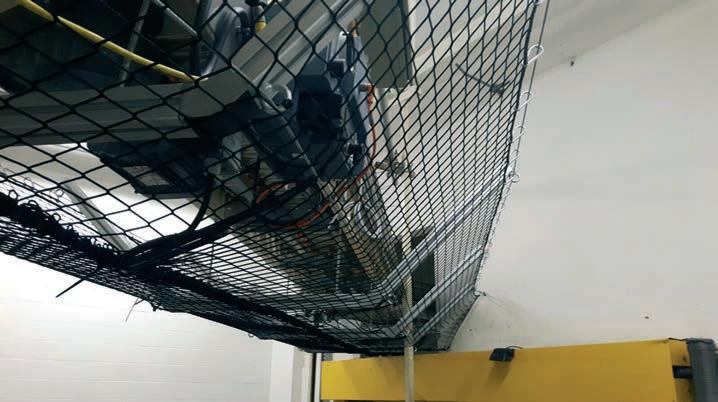


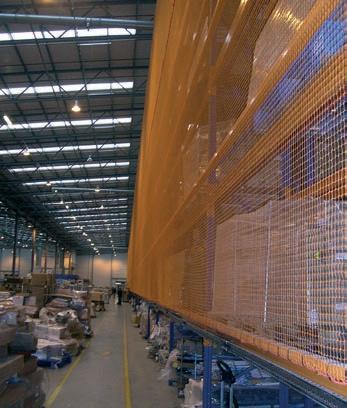




[TOUGHER ECONOMIC TIMES and pressure on public spending are inevitably taking their toll on the overall level of new construction orders; but activity on major construction projects –those worth over £100m – remains healthy as work gets underway on numerous large new developments, particularly in the industrial and commercial sectors.
The November Glenigan Construction Review shows that, while overall project starts were flat in the three months to October, the value of major project starts in the period stood 28% up on the previous three months and 19% up on the same period a year earlier.
More significantly, the new work pipeline for major projects is looking healthier. Detailed planning approvals for major projects virtually doubled in the three months to October and were up by 126% on that period a year earlier.
The green light for more significant industrial and logistics developments is one key driver of the upturn in major projects approvals. Detailed planning approvals granted on major industrial projects were worth £1,914m in the three months to October, almost double the level of the previous three months and an almost five-fold increase on the period a year ago.
The Glenigan data highlights various major industrial projects where construction work is set to get underway. In Middlesbrough, for example, detailed plans have been granted for Tees Valley Lithium to build a £200m manufacturing plant at the Wilton International Site, where work is due to start next March and continue for eight months.
At Castleford in West Yorkshire Axiom Yorkshire is set to submit a planning application for a £153.3m employment and logistics development which will involve almost 1.5 million ft2 of space and 13 industrial units of various sizes. It includes redevelopment of the Castleford Tigers Rugby League stadium (pictured). Work on the project is set to start in spring 2024 and run for 12 months.

Meanwhile, in south east London tenders have recently been returned on a major £106.9m multi-storey industrial development
for GLA Land and Property at Bugsby’s Way. Work on the project, which includes access roads, is set to start next summer and could run for 85 months.
A surge in major new office developments is also creating some significant new opportunities for construction work. Major office project starts worth over £100m each were worth £1,271m in the period from August to October: a five-fold increase on the previous three months and nearly three times the level in that period a year ago.
Glenigan data shows how large office schemes in London have featured heavily amongst the upturn in major projects in the sector. At 55 Gracechurch Street in The City, detailed plans have been granted and work is
due to start next spring on a new £180m office tower for the City of London Corporation, with 29 upper storeys involving 34,000m2 of space.
Meanwhile, Lendlease has recently been appointed as the preferred bidder on Great Portland Estate’s huge £130m new office scheme at 2 Aldermanbury Square in The City, where work is due to start next spring.
Beyond the capital, major office projects set to get underway include Peel Media’s £140m development at MediaCity Plot C3 at Salford in Greater Manchester. Tenders have been returned on the 11-storey scheme which involves almost 30,000m2 of space and where work is set to start early in the new year and run for 37 months. q
[
FURTHER GOOD NEWS for the sector came on 12 December when the Office for National Statistics (ONS) published estimates of construction output for October. Monthly construction output is estimated to have increased 0.8% in volume terms in October – the fourth consecutive monthly growth – with October 2022 being the highest level of construction output (£15,248m) since records began in January 2010.
Anecdotal evidence continues the narrative around the increased prices for certain construction products; however annual price growth is starting to ease from the high level in mid-2022. Despite the current high prices the construction industry is maintaining growth and new orders books remain strong.
The increase in monthly construction output in October came from increases in both new work (0.5%) and repair and maintenance (1.3%) on the month.
At the sector level, five out of the nine sectors saw a rise in October, with the main contributors to the monthly increase seen in private new housing and non-housing repair and maintenance, which increased 2.9% and 1.7% respectively.
The level of construction output in October was 4.8% (£698m) above the February 2020 pre-COVID pandemic level. New work was 0.2% (£21m) above its February 2020 level, while repair and maintenance work was 13.5% (£677m) above the February 2020 level.
Alongside the monthly increase, construction output saw an increase of 1.1% in the three months to October 2022. That is the 12th consecutive period of growth in the three-month-onthree-month series. The increase came solely from growth in new work (3.1%) as repair and maintenance saw a decrease of 2.1%. q
[HOIST & WINCH LTD has recently completed a challenging project for one of the UK’s biggest construction companies involved in large-scale new home development projects. Faced with a demanding and highly technical brief, Hoist & Winch rose to the task, providing a turnkey lifting system solution to ensure complete success for its client.
The requirement was to install a concrete ceiling mounted 7.5t swl (safe working load) lifting beam and manual chain hoist into the basement energy room of a large new tower block. This development is part of a prestigious large-scale regeneration project providing 5,500 sustainable new homes in North London.

At the design stage, following formal tender and contract award, Hoist & Winch set about identifying the optimal solution. Due to restricted access into the basement area, the company decided to utilise a two-piece lifting beam design with an overall length of 7m. To join the two lifting beam sections, Hoist & Winch designed a central splice joint of bolted construction with a reinforced bottom beam flange.
In order to spread the lifting loads over a greater area of the concrete ceiling slab it was
decided to mount the lifting beam via four intermediate cross members, each having a four-bolt/anchor fix into the concrete ceiling at both ends. Featuring a robust bolted construction design it was possible to deliver the lifting beam to site in fully dismantled form for ease of transportation and access.
M24 resin anchors with an embedment of 255mm into the 400mm deep reinforced concrete slab fixed the intermediate cross members directly to the ceiling for maximum security.
For approval by engineers at the main contractor, Hoist & Winch submitted design drawings and calculations for the structural design of the lifting beam and loading of the resin-type ceiling anchors.
With the design approved, Hoist & Winch could progress to manufacturing, followed by delivery to site. Using building column positions as datum points, the installation line of the lifting beam was marked out while working from scissor lifts and an aluminium scaffold tower located on the upper mezzanine floor. A surveyor’s laser line initially identified the correct lifting beam position, prior to overlaying with red chalk to ensure accuracy for the duration of the installation work.
Raising the two lifting beam sections into position required the installation of eight 1t swl hand chain blocks, with each one suspended from M16 swivel eye bolts supported from flush-mounted anchored resin inserts drilled into the concrete ceiling slab.

Following sample pull load testing, Hoist & Winch raised each lifting beam section into position using four 1t swl hand chain blocks. To raise the lifting beams to the full height and clamp them hard against the concrete ceiling slab ready for drilling, the company used two special lifting rigs per beam section.
The first lifting beam section manoeuvred into position also included the 7.5t swl hand chain block, which was rolled on to the lifting beam at low level using a 1t swl hand chain block temporarily suspended from local steelwork. Once both lifting beams were in position, Hoist & Winch joined the two lifting beam sections using the aforementioned bolted splice plate.
Next, the company undertook ceiling slab drilling operations and resin anchor installation for all 32 ceiling anchor points after very carefully cleaning each hole with a special heavy-duty internal brush and suction pump. Following the specified resin curing time, they could tighten each anchor bolt to the required torque levels.
The final installation and test operation was LOLER (Lifting Operations and Lifting Equipment Regulations) inspection of the lifting beam and manual chain hoist unit. This activity included dynamic load testing of the entire runway beam length with a 7.5t skid-mounted

A vital part of the project was the installation line of the lifting beam being marked out while working from scissor lifts
test load followed by 125% static proof load test in accordance with BS 2853 2011.
“Working as a subcontractor for the company supplying and installing the plant and services in the basement energy room, we delivered an entire turnkey lifting system solution,” said Andy Allen, director of Hoist & Winch Ltd.
“At completion we provided the client with an overall project records and documentation package, before clearing all site equipment and undertaking customer handover. This project is just one of many exemplifying the meticulous, competent and professional approach that Hoist & Winch customers can expect from our highly knowledgeable team.” q
• Visit www.hoistandwinch.co.uk for further information and to view recent case studies.


[ASTON VILLA FOOTBALL CLUB has been granted planning approval from Birmingham City Council for phase one of the redevelopment and expansion of Villa Park – to create a world-class sporting venue and a thriving community hub. The decision comes following a consultation period during which the club received nearly 10,000 responses to its redevelopment plans.

According to the club the redevelopment of Villa Park will not only benefit fans and players, but also make a difference beyond the stadium grounds. To do that they are developing a wider masterplan for the suburb of Aston in collaboration with Birmingham City Council and the West Midlands Combined Authority.
The club has developed a series of aspirations that underpin this new era for Villa Park, demonstrating what is important to the club, fans and the local community. Those aspirations are:
• A stadium that is for more than just football
• A catalyst for local regeneration
• An integrated destination for the Midlands
• A dynamic public area for the community
• Inspiring a new generation of football fans
According to the club: “The redevelopment project will increase Villa Park’s capacity to over 50,000 and modernise the stadium to create a world-class sporting venue that can host major international tournaments and compete at the highest level. Villa Park has been shortlisted by the UK and Ireland bid to host the UEFA EURO 2028 Championship.”
The area's regeneration will begin with a £100m-plus investment in the first phase of improvements to Villa Park. Once operational, the project will contribute an estimated £119.9m to the West Midlands economy each year, creating hundreds of jobs during and post-construction, and attracting 1.65 million visitors to the local area annually.
Phase One will include a brand-new North Stand wrapping into Trinity Stand, enhancement of the existing Trinity Stand and the creation of Villa Live – a new 6,500m2 multi-purpose commercial destination to replace the existing shop, academy building and security lodge. It will also involve the redevelopment of the Witton Lane entrance to create over 7,000m2 of new public realm and public space around the North Stand to improve accessibility, biodiversity, safety and the overall experience for fans, visitors and the local community.
Addressing the master plan, the club states: “A vital component of the redevelopment plan is substantially improving the transport system around Aston. We are already working in partnership on this with the West Midlands Combined Authority and West Midlands Rail Executive, who have recently commissioned a feasibility design study to establish the upgrades required and ensure Witton Station meets the future demands of the community and increased visitation to Villa Park, Aston Hall and Aston Park.
“Securing planning approval at Villa Park is an exciting and vital first step in achieving our vision to be a world-class venue and a catalyst for the continued redevelopment of the Aston area as part of the city’s wider masterplan.” q


[THE 2022 ICE Northern Ireland
Sustainability Award has been awarded to the Ballykelly Wastewater Treatment Works Upgrade (pictured). The award was presented by Institute of Civil Engineering president Keith Howells and its Northern Ireland regional chair Stephen Orr at the region’s annual dinner. It was collected by project partners NI Water, BSG and RPS, represented by Mark Brownlee, Cillian Ward and Ryan Murray respectively.
Over 500 ICE members and guests attended the annual dinner at the Europa Hotel, alongside guest speaker Lady Mary Peters, and of course Keith Howells, who was visiting the region.
The Sustainability Award showcases some of the current civil engineering projects in the region that are demonstrating excellence in
sustainability based upon the following criteria:
• Innovation
• Community benefit
• Environmental benefit
• Economy of materials and labour and the
• whole life cost of the scheme
• Value engineering
• Health and safety
ICE NI members had put forward current projects spanning various sectors of civil engineering which represent commitment to environmental sustainability.
Other awards presented at the ICE NI annual dinner included the Adrian Long Medal, which recognises the best paper published in a technical journal. The medal went to Dr Paul Sargent.
Those attending the ICE NI annual dinner raised £6,893.61 to donate to Cancer Focus NI, the charity nominated by the region’s chair. q
Nordic Royal golden copper alloy detailing accentuates the art-deco inspired, subtle opulence of a new, award-winning development in Halifax, Nova Scotia – while also referencing its developer’s history in the capital.


[
for developer Lawen Group, the George Residence combines commercial and residential uses including 164 suites and seven townhouses. The sleek, contemporary design utilises a restrained palette of high-quality materials in neutral colours –accentuated by elegant, crisply detailed and executed Nordic Royal golden copper alloy highlights.

and built
External copper alloy details include impressive portals announcing individual entrances, full height margins inset within the dark brickwork, oversailing soffits on the cantilevered corner tower and reveals to openings around the roof terrace. Thematically, Nordic Royal elements continue internally including lift doors and surrounds, panels accentuating glazed lobby doors and even the smallest details – such as wall corner guards and curved skirtings to columns.
Nordic Royal golden copper alloy gives the building a real sense of opulence and quality, as well as contributing to its art deco feel. But it also acts as a reminder of a special part of the Lawen Group’s family history, embodied in the George Residence –named after the company’s founder George Lawen. The company’s current president and CEO said: “Our team chose to feature the golden copper alloy
at the George in appreciation of its durability and distinguished and dazzling appearance – an ode to our founder.”
Nordic Royal is an innovative alloy of copper with aluminium and zinc, giving a rich golden through-colour that is very stable. The surface retains its golden colour and simply loses some of its sheen as the oxide layer thickens with exposure to the atmosphere, resulting in a protective matt finish.
The Nordic Copper range of architectural copper and alloy products, available from Aurubis – part of the world’s leading integrated copper group and largest copper recycler – includes Nordic Standard ‘mill finish’ and Nordic Brown pre-oxidised copper. The extensive Nordic Blue, Nordic Green and Nordic Turquoise ranges have been developed with properties and colours based on the same brochantite mineralogy found in natural patinas all over the world.
In addition to Nordic Royal, copper alloys include Nordic Bronze and Nordic Brass, which can also be supplied pre-weathered.
A growing series of online ‘copper stories’ exemplify the best in contemporary architecture and showcase the diversity of surfaces, forms and applications available with Nordic Copper today. q
• For more information visit www.nordiccopper.com or email NordicCopper@aurubis.com

[PARLIAMENT HAS LEGISLATED in the Building Safety Act 2022 for a wider Building Safety Levy which will be paid by developers and charged on new residential buildings requiring building control approval in England – not just new high-rise residential buildings.
A new consultation on the design of the Building Safety Levy was published on 22 November, taking into account the expanded scope. The government has launched a new consultation seeking views on the design of the levy and evidence of possible impacts on housing supply and regeneration and the housebuilding industry. That consultation ends on 7 February.
The government is currently introducing a levy on developers who seek regulatory permission to build certain high-rise residential buildings: ‘Gateway 2’.
[GOVERNMENT PROPOSALS to mandate second staircases for new tower blocks have come under fire from sections of the industry as adding unnecessary costs to existing plans and as not being needed. One approved building inspector and fire engineer told Construction News: “This will have some very costly and profound implications for projects that are currently at the design stage. Design can often take three years and constant changes mean additional cost and delay to delivery.”
The consultant, Geoff Wilkinson, pointed to the government’s own consultation papers stating there is ‘no evidence to suggest that existing buildings with a single stair above the proposed threshold pose a life safety risk’.
“If single stairs aren’t unsafe,” he said, “then what is the justification for the additional cost at a time when the industry faces recession, ongoing material cost pressures and some predict a drop in property prices?”
According to the Department for Levelling Up, Housing and Communities, the proposal is ‘the latest step in updating the statutory guidance which underpins building regulations for new buildings to ensure the safety of those living and working there.’
The department is consulting on its plans over a 12-week period ending on 17 March.
Minister for Local Government and Building Safety Lee Rowley said: “There are undoubtedly lessons still to be learnt from the Grenfell Tower tragedy and the Department for Housing is committed to working with the

sector and residents to explore what more needs to be done to make new homes across the country safe.
“This consultation is the next step in the department’s work to improve Building Regulations and make sure they are as clear and effective as possible.”
The proposal followed a call by the National Fire Chiefs Council (NFCC) in November for the government to make it a requirement for all new high-rise residential buildings over 18m or seven storeys to have more than one staircase. In England there is currently no maximum height for residential buildings with only one staircase.
Gavin Tomlinson, NFCC Protection and Business Safety Scrutiny Committee chair commented then: “We are calling on the government to ensure that all new high rise residential buildings over 18 metres, or seven storeys, have more than one fire escape staircase. In the event of a fire, a correctly designed second staircase removes the risk of a single point of failure, buying critical time for firefighting activities, and providing residents with multiple escape routes.”
The Department for Levelling Up, Housing and Communities is also looking at mandating sprinklers in all new care homes, regardless of height, to improve the safety of vulnerable residents and help firefighters with evacuations.
Other measures being considered as part of the consultation include removing references to the national classifications (BS 476) from
The powers to create and set the terms of the levy are set out in the Building Safety Bill, which was introduced to Parliament on 5 July. Following the passage of the Bill through Parliament, the levy will apply to developments in England seeking building control approval from the Building Safety Regulator to start construction of certain buildings: the ‘Gateway 2’ stage of the new building safety regime.
The levy will sit alongside a new tax on developers in the residential property market, which is set to raise at least £2bn over a decade towards the costs of making buildings safer. A separate consultation on the tax is due to close on 22 July 2021. q
Approved Document B. That means the dual system currently in place will end and construction product manufacturers will be required to test their products to the British Standard version of the European Standards.
The government will also be undertaking a call for evidence on revisions to Approved Document B covering materials and products used in external walls. In practice, the call for evidence will seek views from industry on what materials should be covered and how best to improve the clarity of the guidance provided in those paragraphs.
The department says that, since the Grenfell Tower fire, it has undertaken the task of updating and improving fire safety guidance to prevent it from happening again. The department has already made several significant changes to the Building Regulations and its guidance.
q


[THIS YEAR’S FUTUREBUILD EXPO will be happening from 7-9 March at London’s ExCeL. As usual, this year’s show will provide a stage for inspiring ideas, innovative solutions and knowledge sharing to drive sustainable construction and help reach the goal of net zero.
The free ticket to the show will give access to over 400 brands, neverbefore-seen innovations, a world-class conference programme and inspirational seminar content curated by over 90 industry partners.
Stressing this year’s slogan of ‘Taking a Stand’, organisers Easyfairs declared: “Futurebuild is taking a stand for a better built environment and we want you to join us. By getting involved you will drive positive change for your industry, whilst connecting with like-minded people and the innovations that will propel the industry towards a more sustainable future.”
Futurebuild cultivates a collaborative, knowledge-sharing culture through eight show sections across the exhibition. The show sections will provide visitors with innovative solutions that are addressing the biggest challenges facing the built environment.
The Materials section addresses the needs of visitors in search of solutions and innovations in material efficiency. The challenge is to balance the environment crisis against the needs of the population for more buildings and infrastructure. By switching to greener materials that go into construction and improving efficiency, lifetime emissions for buildings can be slashed 44% by 2050.
Visit to find the very latest advances and expertise in materials used in the structure of buildings, that will help reduce the lifetime carbon footprint, enabling specifiers to make the best possible material choices.
The Interiors section will be the leading destination to find manufacturers across all areas of commercial and domestic interiors – including healthy buildings, kitchens, bathrooms, washrooms, surfaces, flooring, lighting, appliances and technology.
The section will provide visitors with the opportunity to network with likeminded professionals involved in housebuilding, commercial fit-out, student accommodation, social housing and the public sector.
Offsite at Futurebuild provides the opportunity to meet and network with likeminded offsite construction professionals who are making significant change within this fast-growing sector.
Visit to find a showcase of the most innovative offsite products, materials, solutions and processes to help drive real change. The Offsite section will showcase the latest advances and innovations within offsite construction, such as volumetric systems, panelised, pod and prefabricated MEP solutions from right across the globe.
The Whole House Retrofit Zone, in partnership with The Retrofit Academy CIC, has expanded this year and will return to Futurebuild 2023 as the Retrofit section.
With 27 million domestic buildings in the UK, the majority of which require
significant energy efficiency improvements, it has been calculated by the UK Green Building Council that 1.8 homes per minute will need to be retrofitted to deliver the UK Government’s commitment to net zero by 2050.
Visit to find a showcase of the best solutions, technologies and services that together can unite and strengthen the delivery of whole house retrofit at scale.
The Sustainable Infrastructure section has been created to meet the needs of thousands of visitors and will include all aspects of infrastructure, including green, blue, grey and social infrastructure solutions.
The Sustainable Infrastructure section will explore all aspects of the city and surrounding city influences, acknowledging that increasing percentages of the population will live in urban areas and so these must be places that work for people.
The Energy section within Futurebuild unites all professionals engaged in designing, specifying, supplying and installing services and products involving energy production and use.
Visit to find the latest technologies and solutions for decarbonisation of heat and the delivery of a smart and flexible energy system.
The Buildings section of Futurebuild covers all aspects of building, including new build, refurb and retrofit across domestic and commercial projects. It will showcase manufacturers and suppliers from across a wide spectrum of building products, including roofing, claddings, renders and bricks, insulation and glazing.
Whether you’re an architect, specifier, building service engineer or local authority representative, you will find the latest building technology, legislation and products relevant to you.
The rapid acceleration of digital technology has transformed the construction industry. More innovation, more data and more technical skills now exist than ever before. The way we design, build and operate our built assets has dramatically changed – and we don’t see it stopping anytime soon.
Technology has become increasingly integral to every aspect of our lives as more systems become automated, digitalised and connected. Smart technology has not only become reality but normality, with so many new and groundbreaking technologies emerging every day.
The Digital Stage at Futurebuild will examine the process, outcomes and benefits that digital construction provides during each stage of the full lifecycle of a built asset from conception to operation.
The whole seminar programme poses the question: what will you take a stand for? Futurebuild is taking a stand for a better built environment and is urging companies and professionals throughout the industry to make a similar commitment by ‘taking a stand’ on an issue they passionately believe will help propel the industry towards a more sustainable future.
To register and make a declaration of what you are taking a stand for and make your commitment visit www.futurebuild.co.uk. The organisers will display all pledges at Futurebuild 2023. q




[
THE SEARCH IS ON for the newest and brightest solutions to an array of built environment challenges. The Big Innovation Pitch will be back in action at Futurebuild 2023 and is where the industry’s most exciting innovators will battle it out to showcase their latest game-changing innovations and revolutionary ideas in front of a live audience.
Futurebuild’s annual innovation competition will provide the stage for the very best industry innovations. Entries closed on 19 December and a shortlist of six finalists will be announced on 23 January. They will then pitch live at Futurebuild 2023 on 8 March, with one being crowned champion.
This year’s event also has a new and added live session, with The Big Ideas Pitch being a motivator for any start-ups and SMEs out there who would like to pitch their new innovation to a wider audience. Run in partnership with the Department for Business, Energy and Industrial Strategy (BEIS), the Big Ideas Pitch is a fantastic chance for new businesses to show how their game-changing innovation can potentially disrupt the built environment.
Martin Hurn, event director at Futurebuild, commented: “Our industry relies on innovation, and faced with the challenges of net zero, companies that innovate will always stay ahead of the curve. At Futurebuild, this innovation is part of our ethos which is why the Big
Innovation Pitch is such a great platform to highlight these innovations.
“We are also delighted this year to be able to open up the field even further with start-ups and SMEs being able to bring their breakthrough ideas to a wider audience through the Big Ideas Pitch. There is a wealth of talent across the UK and finding solutions that have the potential to meet wider industry issues is truly amazing, and we are excited to see the companies present their ideas in front of a live audience and get the attention they deserve.”
Last year’s hotly contested live final saw Sunamp win the Big Innovation Pitch with their product Thermino Thermal Storage Battery for Domestic Hot Water. It uses food-grade phase-change materials for more efficient heat storage, delivering instant hot water while reducing carbon emissions. While the battery is up to four times smaller than an equivalent hot water cylinder, it has an energy density around five times greater than water.
Toby Morris, specification sales manager at Sunamp, said: “Winning helped increase our profile at the event and beyond, raised brand awareness and started conversations. Sales of Thermino units are strong and are moving into the mainstream. They are now being installed in large scale housing projects across the country and international sales are rising.” q
[REACHING NET ZERO by 2050 is no simple task and no one person or company has all the answers. That’s why it is essential to share knowledge and learn from each other, so we can effect real positive change in the built environment.
By handing over the reins of its seminar programme to the great thinkers and disruptors in the sector, Futurebuild is doing its part to share the knowledge, give a forum to ask questions and, as a collective, start to bring to life some of the answers to help deliver a better built environment.



Curated and delivered by over 90 industryleading partners and featuring a stellar line-up of over 300 speakers, the seminar programme is bringing the whole industry together to debate and learn from each other.
The three-day programme will educate and inform across a range of subject areas with content that is relevant now. The programme
features practical and actionable CPD-accredited sessions, so visitors can gain many CPD points in one visit and at the same time acquire the knowledge and skills that will help them in their day-to-day roles.
Expanded for 2023, 135 seminar sessions will offer strength and breadth of content and will be delivered across seven seminar stages: Materials, Interiors & Lighting, Buildings & Offsite, Retrofit, Sustainable Infrastructure, Energy & District Energy and Digital.
Stand out sessions from across the ambitious programme include masterclasses with Bill Dunster, architect and founder of ZedPower; Duncan Baker-Brown, co-founder of BBM Sustainable Design Ltd; Zerlina Hughes, founder and creative director of Studio ZNA; Dr Tom Woolley, architect and academic; and David Cheshire, sustainability director at AECOM. They
will explore and tackle some of the industry’s biggest and most critical topics, from ‘zero bills’ homes to material use, lighting design to biobased materials and building a circular future.
“Our well-respected seminar programme will provide an opportunity for companies and professionals throughout the construction supply chain to take a stand and speak on issues they are passionate about. These daily sessions on each of the stages will share the latest thinking and research to update, inform and inspire visitors to make a positive change,” explained Martin Hurn, event director at Futurebuild. “By inviting pioneers in sustainability to share their success stories, it’s time for the industry to gather and take a stand, too.”
Check out the full seminar programme and speaker line-up by visiting the Futurebuild website at www.futurebuild.co.uk q
[CISRS HAS BEEN SUBSIDISING a series of CISRS Operative Training Scheme (COTS) one-day courses for the first time ever throughout the autumn and winter – helping to supply some much-needed boots on the ground in the scaffolding and access sector for 2023.
The CISRS funding has enabled the participating training centres to put on COTS courses for only £50 per delegate – a substantial saving for businesses and individuals alike.
The aim of providing the subsidy is to attract more young people straight from school or college into the scaffolding sector, with the right training. But existing Labourer Card holders can also benefit – as CISRS Scaffolding Labourer (Green) Card holders are required to take the COTS course to renew their card every five years.
The COTS course teaches the basics of the industry and how to work safely with scaffolding and access equipment. Upon successful completion of the course, and with a CITB HS&E Test (or recognised exemption), delegates will receive their first CISRS Scaffolder Trainee or CISRS Scaffolder Labourer Card. Information about each card can be found in the new CISRS CAP 609 General Information Booklet which is available to order for free at www.cisrs.org.uk
The CISRS one-day COTS course Includes:
• Relevant regulations and codes of practice
• General scaffolding responsibilities
• Basic scaffolding terminology
• Servicing of equipment
• Boards & stock • Quality control
• Health, welfare, hygiene and housekeeping
• Electrical safety • Mental health awareness
• Fire prevention • Controlling NVH
• Working at height
• Accident prevention and reporting
• PPE (Personal Protective Equipment)
• Site transport safety (including loading and unloading)
• Equipment and tools • Manual handling
• Lifting equipment • Using a rope and wheel
CISRS will waive the usual costs of the delegate training folders and card application fees normally incurred in the delivery of these courses.
Dave Mosley, CISRS scheme manager and NASC director of training, said: “The commissioning of these subsidised courses will see CISRS reinvest in excess of £100k in 2022. This subsidy is making great use of CISRS generated income – offering a chance to get new people into the scaffolding sector on fantastic value COTS courses.
“CISRS is a not-for-profit organisation, and as such we are always keen to look for positive and beneficial initiatives like this to redirect income back into supporting the scaffold training industry.
“A big thanks to all of the fantastic training centres for participating in this – supporting the industry from the bottom up. We are sure the courses will be successful and inject a burst of new energy and numbers into the sector, assisting with the current labour shortages many firms and the whole construction industry is facing.” q
• CISRS centre contact details can be found on the CISRS website at www.cisrs.org.uk
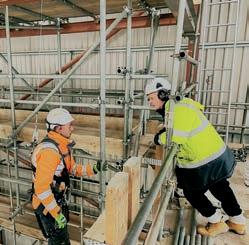
[CISRS HAS BEEN awarded a CITB commission to help fund the development and training of 16 new scaffolding training instructors within England and Wales – in a bid to boost up numbers into the scaffolding industry.

The plan is to make the job of a scaffolding instructor an attractive change of career for 16 Advanced Scaffolders –particularly in the following regions in the UK, which have been identified as being most in need of support: Wales; South West; North West; Midlands; North East (Humber and North Yorkshire); and South Central (Hampshire, IOW, Berkshire, West Sussex, Buckinghamshire, Oxfordshire and Surrey).
These extra numbers in regions most needing support will then be able to help train up more scaffolders – to help in the NASC & CISRS mission to boost numbers coming into scaffolding.
CISRS scheme manager and NASC managing director Dave Mosley said: “CISRS will be making all efforts to ensure that those regions lacking training numbers are covered by the generous CITB funding. We have met with a number of training centres who are fully on board to help recruit, train and retain some much needed new scaffolding instructors into the industry – in a bid to bump up the numbers being trained, to help ease the skills crisis. The aim is to offer full training and support to new recruits to get them up to at least Part 1 approval status as soon as possible.
“Scaffolding instruction and scaffolding itself is a great job option for those who are considering a career – or change of career – in construction. It’s a well established, future-proofed industry. If you are considering a change of direction within the sector, sharing your skills and maintaining your own high standards of training, why not be part of the upcoming new instructors workforce?” q
• Interested scaffolding instructor applicants should contact CISRS by emailing instructors@cisrs.org.uk with details of where they are based and the regions they would be interested in working in. Please note that all applicants need to hold a CISRS Advanced Card and have previously held a CISRS Scaffolder Card for over 10 years.
[
THE NASC has launched SG4:22: Preventing Falls in Scaffolding Operations. This long awaited, core NASC safety guidance provides industry best practice for fall prevention when erecting tube and fitting and now also includes system scaffolding.

SG4:22 features 60 pages of detailed scaffolding sector analysis and safety guidance, with 95 key figures and illustrations to bring it to life.

Initially the document is available to download as a PDF from the NASC ePortal, but handy A6 SG4 user guide booklets are in the pipeline. For now, the NASC states that current SG4:15YOU booklets can still be issued to scaffolders – alongside a briefing on the main changes to SG4 – until SG4:22 booklets become available in early 2023.
The key changes in SG4:22 are:
• The removal of obsolete technology
• The inclusion of case studies
• highlighting accident and
• enforcement learning
• The embracing of new technology
• – eg drones and 3D modelling
• Updates to reflect changes brought
• in with TG20:21 – such as TG20
• loading bays
• The inclusion of modular system scaffolding as well as traditional tube
• and fitting
• Additional safety guidance on working on beams
• Hazards, risks and control measures required when working on
• fragile roofs
• Improved Safe System of Work (SSOW) for temporary roofs and the
• prevention of falls
Speaking about the launch of SG4:22, acting NASC managing director Dave Mosley said: “SG4 has long been one of the most important documents in the access industry, as such it is imperative that it receives a thorough review every five years. Since its introduction it has gone a very long way to help make our industry a safer place – for NASC members and non-members alike. It is a must-have document for anyone involved in working at height, scaffolding and access.”
SG4:22 technical author and Simian managing director Simon Hughes added: “Having been involved with NASC for over 25 years, I am proud to be associated with the confederation and particularly in the development of their flagship safety guidance.
“Since the first edition of SG4, which was published well over two decades ago, the scaffolding industry and the standards that support it have seen significant development, as they seek to reflect technological advancements, modern working practices and the lessons learned by industry.
“NASC’s publications are widely
respected as industry best practice the world over, and I am pleased to have had the opportunity to be involved in the review and production of this edition, which will hopefully yield improved standards of safety.”
Suzannah Nichol MBE, chief executive of Build UK, provided the following foreword to SG4:22: “The application of consistently high standards is key to both safety and productivity on construction projects. Scaffolding professionals provide temporary working platforms and other structures that are used throughout the construction sector and they often face significant risks in establishing safe temporary access and work environments for other workers.
“Specialist construction trades, such as scaffolders, perform a vital role in our supply chain and we all rely upon current industry guidance to establish and maintain safe working practices that have become the benchmark for our members’ projects.
“Written by NASC and industry experts, over the years this guidance has challenged industry practices and has clearly demonstrated an impact in saving lives and preventing serious injury. All scaffolding operatives should hold a current CISRS card and be trained to SG4:22 Preventing Falls in Scaffolding Operations which sets the standard across the UK.” q
• SG4:22 Management Guide is available to download as a PDF from the NASC e-Portal now. Contact the NASC office for more details on 020 7822 7400 or email enquiries@nasc.org.uk
[
INCOMING NASC president David Brown, managing director of IBN Scaffold Access Ltd, has outlined the core objectives for his presidency in his inaugural speech at the NASC AGM and Awards 2022.

David’s primary focus will be supporting NASC member companies through the labour shortages by subsidising the training of new starters, scaffolding and office-based newly-qualified scaffolders, advanced scaffolders and scaffold supervisors as well as both CISRS System Scaffold Product Training Scheme (SSPTS) and system inspection endorsements.
He said “We must recruit new starters into the industry. We rely on new blood coming into scaffolding to keep this amazing trade going. As well as recruiting new starters it is vital that we improve the skills shortage in the construction industry and that NASC members continue to train and upskill their workforce, that is why NASC are making available training grants on a scale that has not been offered before to member companies.”
The NASC will issue clear guidance on the qualifying criteria in the coming weeks. David will also be supporting NASC member companies and the wider scaffolding sector into achieving carbon neutrality.
David said: “The environment is without question something I am passionate about and I want to be able to help reduce the environmental impact our industry has during my term as president. Carbon net zero is being discussed more and more within the construction sector. The NASC intends to fully support and guide the membership through this and to ensure all of our members are able to meet with the government requirements.
“The NASC appreciates the difficulty of trading in this industry at this moment in time and has no intention of making it even harder by putting obstacles in members’ way that impact on their business. But carbon net zero is approaching and all businesses must be compliant by 2050. Rather than adding this to the membership criteria without offering help and support, the NASC will be providing guidance, access to information and supporting our members in order for you to achieve this. We recently issued guidance note SE1:22 – Becoming Net Zero Carbon , which explains what carbon net zero is and the new language that is used to describe this initiative. But more will follow.”
David’s strategies and net zero campaign details will be unveiled in due course, but the mission has already started – by offsetting the carbon output generated from hosting the NASC Awards 2022 in central London with the planting of 120 trees in December using Exeter-based firm Oak Offset.
David is also keen to support charities in his two-year term as NASC president. The NASC’s charity of choice is The Lighthouse Club – who provide financial and emotional support to the construction community and their families – and they will continue to receive the organisation’s support, pledged in earnest on the evening of the NASC Awards with a cheque for £5,000.
Each year the NASC president is asked to nominate a charity that they would like the confederation to support. This year David
has chosen Young Epilepsy – a charity close to his heart. David’s daughter Alex developed epilepsy aged two; she is now six and enjoying a full and happy childhood, helped by the guidance provided by the charity.
The CEO of Young Epilepsy, Mark Devlin, was presented with a cheque for £5,000 from the NASC on the evening of the awards ceremony.
Speaking to the audience David continued: “We can’t stand still. We must keep on improving. That is why we conducted the B2B business review of the NASC; today we have re-launched the NASC charter and will be publishing the NASC business development plan.
“We’ve listened to our members, clients and prospective members to ensure NASC remains relevant to all sectors of industry today. I’m proud to say that it is and will continue under my presidency to better represent members’ needs, promote ‘NASC only’ status from main contractors and clients and also continue the work being done towards tackling the labour shortage in our sector.
“Scaffolding is a fantastic sector to work in; we need to promote this more widely. We need to be proud of our NASC – our members don’t just pay for a badge and then buy guidance from elsewhere. NASC members are the leaders in our industry.
“I’d like to announce my full support for the NASC promoting ‘NASC only’ to main contractors, clients, local authorities and government. Over recent years the criteria from main contractors have changed. ‘NASC Member Companies Only’ used to be the criteria on PQQ documents issued and, during my term as president, we need to get back to this.
“My message to main contractors is simple: Do you want to employ scaffolding contractors who help produce the industry guidance and set the standard for the scaffolding industry? Do you want to employ the scaffolding contractors who year after year are reducing their accident statistics and improving the industry? Do you want safe and compliant companies working on your projects? Do you want scaffolding companies who are fully audited and who are using materials fully in accordance with NASC product purchasing guidelines? Only by employing an NASC member company do you get this as a minimum.” q
[
THE International Powered Access Federation (IPAF) has issued a further update in regard to industry concerns around the use of the platform emergency stop function in mobile elevating work platforms (MEWPs), following a meeting of representatives of its Training Committee, International Safety Committee and Manufacturers’ Technical Committee.
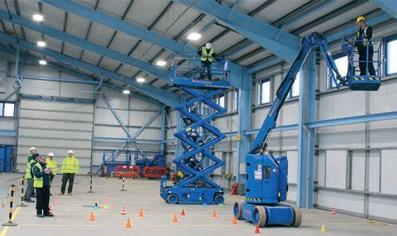
Brian Parker, IPAF’s head of safety and technical, commented: “On 13 December, and further to detailed discussions across the industry, IPAF convened another meeting of its safety, training and technical experts and committee representatives to consider on-going issues of concern around the use of the emergency stop, or ‘E-Stop’, to isolate platform controls in order to mitigate risk from unintended or accidental movement of machines while occupants are working at height.
“IPAF conducted a survey of equipment manufacturers to establish the level of concern about this widespread industry practice, and while the majority of respondents were unconcerned, a small but significant number of respondents said that they do have concerns about using the emergency stop to isolate platform controls while working at height.
“IPAF will continue to liaise with manufacturers to further understand both the specific concerns raised, and the breadth of concern across the industry in regard to this practice, and to help evaluate the balance of risks identified. If any specific concerns identified require it, IPAF safety guidance and/or content in IPAF training courses will be modified to cover any risks not previously addressed.
“IPAF maintains that, based on analysis of data about incidents and near-
misses reported via IPAF’s accident reporting portal, across an industry that has both new and older designs in service, there remains a significant risk related to the involuntary or accidental activation of the machine platform controls. One way to mitigate this is to isolate the platform controls while working at height – this is explained as part of the IPAF MEWP operator training course and is acknowledged as industry safe practice.
“We wish to reiterate our earlier advice that IPAF always recommends following the MEWP manufacturers’ recommendations in full, including the information contained in the operator’s manual. We wish to restate that, in addition to being trained, all MEWP operators must carry out thorough machine-specific familiarisation prior to using any MEWP. As part of this, operators and those who oversee MEWP operations – such as supervisors, foremen or managers – should be aware of the platform emergency stop function, how and when to use it, and what functions are disabled when it is activated.
“We continue to communicate with MEWP manufacturers, both directly and via IPAF’s Manufacturers’ Technical Committee, as well as our rental and training members, contractors and end users, to ensure that all concerns are addressed and to communicate up-to-date safety and technical guidance based on the best available incident data and risk analysis.” q
• For all of IPAF’s safety and technical resources, including Toolbox Talk workplace briefings and Andy Access safety posters, visit the website at www.ipaf.org/resources
[
DAVE MOSLEY, acting managing director of the NASC, has been voted in as vice president (economy and law) of Union Europaischer Gerustbaubetriebe (UEG) at their Annual General Assembly in Cologne.
The UEG represents the interests of the scaffolding sector across Europe. It was founded on 10 October 2008, with NASC joining in 2009 represented by Robin James and Dave Mosley.
Other members are national scaffolding associations from Germany, Netherlands, Poland, Switzerland, Norway, Finland, Sweden, France and Luxembourg, with the UEG board currently in on-going discussion with several other national federations.

UEG also has a range of producers, manufacturers and industry experts as associate members who bring their support and knowledge, representing the wider group best interests via their roles on several Eurpoean Standard setting bodies.
Dave Mosley said: “I am very proud to have been appointed as vice president of UEG and would like to thank the

members for voting for me.
“NASC has been involved with the federation almost from the beginning. It is essential that our voice is heard during the discussions that take place in Europe, as they could have serious consequences on standards regarding materials, labour, training and other aspects of the scaffolding industry back in the UK.
“Over the years, we have met some incredibly knowledgeable and experienced industry representatives via UEG and made some great friends and allies. Not every member will have the same opinion on a particular subject but through discussion we can usually reach a consensus, which will help to move us collectively in the right direction.”
Dave attends regular meetings and takes part in several working groups. The UEG continuously strives to raise standards and set minimum requirements across the European sector. q
[THE ACCESS INDUSTRY FORUM (AIF) has warned that the government is planning to scrap the UK’s Work at Height Regulations at the end of this year, and has launched a campaign to force a change of mind.

“This law is important to anyone who works at height as part of their job,” the forum stated. “It’s a daily occurrence, with an estimated 10 million of us climbing a ladder, ascending scaffolding or finding another way to work at height every year. This encompasses everyone from construction workers and steeplejacks to teaching assistants, shop workers and artists.”
The regulations set out what workers need to do to manage risks from working at height, and provide a simple set of rules that prevent people from falling. Without them, employers wouldn’t have to ensure workers are competent, select suitable access equipment for each task or inspect that equipment regularly.
The need to address the specific risks involved in working at height has been recognised in legislation for nearly 60 years, but historically only covered the construction sector. The 2005 Work at Height Regulations marked a major step change, with protection finally extended to people in all industries who work at height.
Those regulations are covered by the Retained EU Law (Revocation and Reform) Bill, which is currently passing through Parliament. The Bill seeks to remove EU-derived laws that remain on the UK statute book following Brexit. It aims to ‘sunset’ over 2,400 laws; the Work at Height Regulations comprise just one of them. There are others within the health and safety category, including the Manual Handling Operations Regulations and Personal Protective Equipment at Work Regulations.
If the Retained EU Law (Revocation and Reform) Bill passes, the whole lot will automatically be axed on 31 December 2023 unless the government takes action to save individual regulations.
The AIF continued: “We need to do more to prevent falls from height, not weaken the protections that are already embedded in workplaces across the UK and have been working well for 17 years.
“The UK is a world-leader in preventing falls from height and should be proud of our consistently low fatality rates and our internationally recognised expertise. The Work at Height Regulations are a cornerstone of our national strategy to prevent falls. But by the end of next year, they could be gone.”
In British workplaces the number of falls from height has declined while the Work at Height Regulations have been in place. The year before they were introduced there were 67 fatal falls, making up 29% of total fatalities. Last year, there were 29 fatal falls, which was 24% of total fatalities.
However, falling from height is still the most common cause of workplace fatalities – the AIF points out that there have been 683 since 2005. It also causes 8% of non-fatal injuries, according to statistics released by the Health & Safety Executive in November.
Falls from height create devastated families and life-changing injuries. They lead to mental health problems, financial worries and long-term care needs. The consequences can last a lifetime and they affect society as a whole. The annual cost to society is £620m, which covers NHS spending, benefit payments and tax losses.
The Access Industry Forum – which unites the 10 principal trade associations and federations involved in work at height – has submitted written evidence to the House of Commons Public Bill Committee, which is now considering the Retained EU Law (Revocation and Reform) Bill.
AIF chair Peter Bennett OBE declared: “Employers don’t want falls from height in their workplaces. They want their workers to be safe and free from harm. They also want to avoid the investigations, negative publicity, delays, increased insurance premiums and upheaval of responding to an accident.
“The Work at Height Regulations is a compact piece of legislation that creates a useful framework for employers to manage the risks and avoid falls from height. The rules are straightforward and practical; they’re embedded in existing policies, procedures and training and, although they’re not perfect, the most important thing is that they work. I’m in no doubt that the Work at Height Regulations have saved lives and if this legislation cannot be rescued from the scrapheap it’s workers who will pay the highest price of all.”
The AIF is urging people to write to their MPs to ask them to push for the Work at Height Regulations to be assimilated into UK law and excluded from ‘sunset clauses’ within the EU Law (Revocation and Reform) Bill.
There is a Save the Working at Height Regulations Campaign newsletter, which can be subscribed to via accessindustryforum.org. uk/#newslettersignup q

[ LEADING BUILDING products
manufacturer Forterra has named eight colleges across the country as Construction Hubs – part of a scheme that aligns with Forterra's mission to ‘keep Britain building’ by plugging the skills gap.
The selected colleges are Buckinghamshire College Group, Burnley College, Hertford Regional College, Lewisham College, Preston College, Stamford College, Truro and Penwith College and Warrington and Vale Royal College.
Forterra manufactures a diverse range of concrete and clay building products, employing around 1,800 people across 17 manufacturing facilities in the UK. Its London Brick Construction Hubs are named after the historic brickmaker which is now owned by Forterra.

The colleges named as hubs benefit from expert advice and support from leading figures in the construction industry, who will share their industry knowledge through a series of site visits and talks, supporting the emerging talent from each college. The colleges will also enjoy a boost to their resources with a donation of 12,000 bricks, branded merchandise and the opportunity for one exemplary student to receive £500 worth of tools.
With the support of Forterra the colleges are set to embark on various brickwork projects, including internal competitions and local community projects, with the aim of increasing the skills and enthusiasm of their students.
Forterra’s chief executive Stephen Harrison commented: “We are pleased to announce the eight colleges selected to join the London Brick Construction Hubs. We have been impressed by the high standard of applications received, and have every confidence that these colleges and their students will go on to produce brickwork of the highest quality. Forterra takes pride in supporting the continued development of high standards and technical skills in the
bricklaying industry with the view of bolstering future UK productivity.”
Forterra also continues to support upcoming bricklaying talent in a variety of ways, including through the Forterra London Apprentice Challenge and the annual Best in London Brick contest at Lewisham College, which uses Forterra's iconic London Brick.
For more information on Forterra's Construction Hubs visit www.forterra.co.uk q
[ IN NOVEMBER the winners of the SkillBuild National Finals 2022 emerged, after nearly 80 construction trainees went head-tohead over three days at Edinburgh College. SkillBuild, often dubbed the ‘Skills Olympics’, is delivered by CITB in partnership with WorldSkills UK and offers a chance for trainees to compete in a bid to be crowned winner of their chosen trade.
SkillBuild is the largest multi-trade competition in the UK for construction trainees and apprentices. As competitors progress through each stage they are tested on their technical abilities, time management, character and commitment. The competition is viewed by many as an opportunity to develop confidence, self-esteem and life skills, along with the potential for the highest-scoring eligible competitors to join ‘Squad UK’ and compete internationally.
Following the Regional Qualifiers, which were held at various colleges across the UK, the National Finals took place at Edinburgh College from 15-17 November. The event attracted roughly 1,000 school visitors from across Edinburgh and the Lothians, exhibiting the variety of skills and career opportunities available within the industry.
Tim Balcon, CITB chief executive, exclaimed: “I’m delighted to have been able to attend yet another year of SkillBuild, my
favourite day in the calendar. It’s fantastic to meet all the talented individuals and hear about their career aspirations. It’s so important that we support this next generation of talent coming through to industry, encouraging them to pursue their passions and reach their full potential.
“It’s initiatives like SkillBuild that really make a huge difference and I’d like to thank everyone involved in making this year’s competition possible. Many congratulations to all the winners and everyone who competed, you should all be incredibly proud of yourselves.”
Ben Blackledge, deputy chief executive of WorldSkills UK, added: “Congratulations to all the medal winners. It is a fantastic achievement, and we hope their success will inspire more people to consider an apprenticeship and technical training as a route to great career success.
“Using insights gained from our competition-based programmes, we work with our partners to raise standards in training, helping to drive economic growth across the UK.”
All the medal winners and highly-commended entrants in all 11 skills taking part are available to view at www.goconstruct.org/skillbuild, together with details of how to pre-register for this year’s competition.
[WHEN PEOPLE THINK of male-dominated industries, it is likely that construction comes to mind. The physically demanding labour needed on a construction site is often associated with men. However, apprentice Alice Heaton, alongside training provider Grantham College & University Centre and her employer JRL Brickwork Ltd, are working hard to break down those gender stereotypes. The skills shortage in construction has been a growing concern for construction companies and as more time goes by the problem becomes more pressing.
One of the main reasons for the UK skills shortage – specifically in the construction industry – is an ageing workforce. As construction workers reach retirement age fewer people are entering the industry to replace them. There has never been a more important time for construction employers to invest in the next generation of workers. Encouraging more women to join the construction field, as well as offering apprenticeships, will certainly help fill the gaps.
Alice has always been keen to pursue a career in bricklaying as she wanted to challenge herself in a role that enabled her to stay physically fit; and she loves the idea of being able to build her own house one day. After completing a full-time course at Grantham College & University Centre she decided her natural progression route was to undertake an apprenticeship. Alice has been working for JRL Brickwork since September and it is clear that she has already made a lasting impression with her employer.
Director James Laurie explained: “Alice has made excellent progress during her time working at JRL. As a firm believer in the apprenticeship process and understanding the need to grow future talent, we as a company employ a minimum of five apprentices per year. Our retention rate of apprentices after they complete their qualification is extremely high, with many of our previous apprentices now running gangs or in managerial roles within the company.
“Alice is the first female apprentice we have employed and we are keen to grow that in the future. We offer a package of support to all of our employees,
male or female; but it has been imperative to me that Alice feels safe, secure and valued within the team and the outside environment in which she is working. We have a duty of care to ensure that she is not faced with any gender prejudice and so far she has had nothing but a positive experience when on site.”
Alice has had experience of working on smaller one-off builds and has now started work on a much larger housing estate site, project managed by C3 Construction.
Said Alice: “I am really enjoying working on site and have learnt so much in the short time I have been here, such as doing plots and English bond walls. I was initially nervous going from private to site work and did expect some of the stereotypical, sexist comments. However, everyone has been so helpful and eager to support me when needed.

“As a female, it has been a challenge working in this sector as you fear that some may see you as a bit of a novelty. I feel like I have had to work twice as hard to prove myself and my ability, but I have earned the respect of my colleagues, who treat me as they would any other employee.
“I have found undertaking an apprenticeship so rewarding as I am able to gain a valuable insight into what goes on in the industry, as well as learn the theoretical side at college – all while getting paid to do so! Having a supportive employer makes all of the difference to your experience and I feel lucky to be part of the company I work for.”
When asked what advice she would give to any women wanting to join the industry, Alice said: “Go for it! As long as you are determined, thick-skinned and hardworking, then nothing can stop you.”
With Alice’s grit and drive, it is evident that she has a successful career in bricklaying ahead of her and will hopefully inspire other females to follow her lead. q


• To find out more visit www.grantham.ac.uk
[THE Construction Plant-hire Association’s CPA Stars of the Future awards are now open for entries. The awards scheme for apprentices and trainees in the construction plant sector was set up by the CPA over 10 years ago.
The awards are intended to recognise and reward outstanding apprentices and trainees who not only bring ability and commitment to their learning and their work, but also possess those extra capabilities and attitudes which mark them out as being not only the foundations of the future of the industry, but also potentially its future leaders – the Stars of the Future.
There are six existing categories, each with their own distinctive award: Plant Mechanic (Level 2),
Plant Technician (Level 3), Lifting Technician, Plant Operative, Hire Controller and Plant Installer.
All apprentices and those on formal training programmes for each category are eligible. Employers and training providers need to complete a nomination form which seeks information about the skills, achievements and attributes of the apprentice or trainee.
Although ‘Stars’ is intended to recognise and reward outstanding apprentices and trainees who are recognised as the foundation for the future of the industry and potentially its future leaders, the successful learning journey of any apprentice or trainee is only possible through the guidance, help and support provided by co-workers and/or
other employees of the organisation.
To recognise individuals who’ve willingly undertaken that important function, a new Stars award is being provided in 2023 for the role of Apprentice Mentor. Employers are invited to nominate a co-worker who has been designated to directly assist the apprentice /trainee during their learning journey and who should be recognised as a role model for others to seek future roles as a mentor.
The Stars of the Future 2023 awards ceremony will take place at the Heart of England Conference and Events Centre in Fillongley near Coventry on 6 July 2023 and all nominees and their employees are invited to attend the event. q
[
GLASGOW has a rich heritage of Victorian architecture – from Sir George Gilbert Scott’s gothic-revival university and the exquisite detailing of Charles Rennie Mackintosh’s Glasgow School of Art to its famous sandstone tenements. They are complex and often unique buildings that, after more than a century of wear, tear and pollution, increasingly need people skilled in traditional construction techniques to care for them.
At West College Scotland (WCS), the modern campuses may be steel and concrete but every year scores of construction students and apprentices leave with the qualifications and skills that will enable them to pursue a career in helping preserve Scotland’s past. But in a digital, forward-looking age how do you get prospective students excited about the past?
At West College they have taken the hands-on approach – working with local authorities and construction companies to offer hundreds
of schoolchildren the chance to take part in traditional building craft workshops. Taster sessions held on-site at major active projects – such as the £22m refurbishment and transformation of Paisley’s Category A-listed Town Hall – offer pupils the chance to try wood turning, painting, slating and even leadwork.
It’s a unique, long-term approach involving a lot of collaboration and organisation but, along with community and business partners including Renfrewshire Council and Morrison Construction among others, the college hope it is an investment that will pay off – planting a seed in a 13-year-old mind that will hopefully in time encourage them to consider starting their journey into these fields when leaving school. q
• For more information visit the website at www.westcollegescotland.ac.uk or email info@wcs.ac.uk
[A NEW Enfield Construction Skills Academy is set to open in early 2023 to create thousands of new jobs to support the £6bn Meridian Water regeneration in the London borough.
Capital City College Group (CCCG) is working with Enfield Council and Vistry Partnerships to bring forward Meridian One – the first 300 homes of this major regeneration scheme, which in total will deliver 10,000 new homes.
The academy will provide opportunities for at least 500 people a year to gain the skills and qualifications needed for jobs on the site and beyond.
Training will be provided by College of Haringey, Enfield and North East London (CONEL), which is part of CCCG, with a focus on sustainable construction methods including retrofitting and higher energy insulation.
The academy will tie in with CONEL’s Mayor of London Green Academy
Hub, which was set up to support London’s economic recovery from the COVID pandemic.
Apprenticeships will be available in plumbing, electrical installations, carpentry, brickwork, thermal insulation, assembly and installation, design and build, floor laying, roofing, groundworks, site supervision and engineering.
The academy will also run free introductory short courses in carpentry, plumbing, plastering, window fitting, sanitation, heat pumps, solar energy, computer-aided design, environmental technologies and employability skills. q

• Find out how you can work in partnership with CCCG to deliver the skills needed for your business by calling 0208 442 3055.
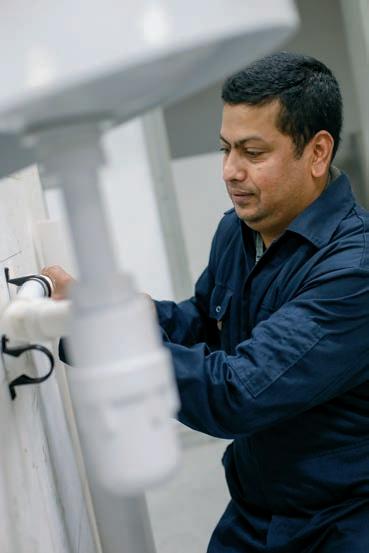
[
SCHOOL LEAVERS, career changers and employers looking to upskill their workforce can all benefit from the wide range of construction apprenticeships on offer at New College Durham.

Apprenticeships are the perfect way to kickstart a career in construction. These dynamic training programmes give school leavers the chance to gain work experience, get a nationally recognised qualification and earn a wage. The college runs construction apprenticeships in a variety of roles including carpentry and joinery, construction and civil engineering, painting and decorating, plumbing and heating, property maintenance and electrical installation.
Career changers are often faced with the daunting prospect of giving up paid employment to study a degree full time. Higher apprenticeships allow people to earn a wage while also gaining a university-level qualification and on-the-job experience. The college currently has higher Apprenticeship programmes that can lead to careers as design and build technicians, site engineering technicians, quantity surveying technicians and site supervisors.
Apprenticeships are also an ideal way for employers to upskill their workforce as flexible and part-time study options allow employees to continuing working while they study. New College Durham has over 50 years’ experience of planning, managing and delivering apprenticeship training. They work with over 450 employers across the North East region and can tailor training to meet a business’s specific needs.
Andy Broadbent, principal and CEO of New College Durham, said: “The UK construction industry needs to attract new recruits to meet the increased demand for skills and to replace those leaving the sector. At New College Durham we want to ensure that workers entering the sector and those
currently employed in construction have access to first-class training. “Employability is at the heart of everything we do. We design our courses in partnership with businesses to guarantee our students get the skills that employers need. Our students have access to state-of-the-art facilities in the North East Institute of Technology centre. We’ve recently invested £1m in the most up-to-date building information modelling equipment and manufacturing robotics technology so students can experience the latest industry innovations.” q
• Find out more about the construction courses on offer at New College Durham at www.newdur.ac.uk
[LAST OCTOBER staff at Brunel Construction Centre, Kirklees College, were presented with their City & Guilds Excellence in End-Point Assessment (EPA) plaque. This was the first year their construction apprentices undertook their EPA at Kirklees College – and it showcases their competence in their chosen career. Students demonstrated to independent assessors the knowledge, skills and behaviours they gained thanks in part to the outstanding training delivered by the college in brickwork, joinery, plastering, plumbing and property maintenance.
The award was presented to assistant principal Lisa Buckley, head of construction Steve Plumstead and curriculum managers Rob Tulk and Paul Whitaker by Laura Harrap, City & Guilds business development manager Yorkshire & North East. Laura said: “As a result of your high pass rates and the number of distinctions achieved at your centre, we are pleased to award our Excellence in EPA delivery plaque for proud display at your premises, to showcase the quality of your training and delivery.”
Lisa Buckley commented: “We are really proud to receive this award as external recognition of our fantastic staff team and the amazing job they do in training apprentices and helping so many fulfil their potential as qualified tradespeople.”

The plaque has been proudly displayed at Brunel Construction Centre
ever since and serves to show both current and prospective students of the high level of teaching and learning at Kirklees College. q
• You can find out more about construction at Kirklees College by visiting www.kirkleescollege.ac.uk/subjects/construction/
[ BRIGHTON MET is excited to introduce a brand new T Level qualification in Construction, Design, Surveying & Planning starting in September 2023. The qualification has been created in conjunction with industry experts and will be equivalent to three A Levels.
Students will learn about a range of construction topics, including project management, principles of design, commercial construction and entrepreneurship. With the construction industry always evolving, students will dive into the world of digital technology, innovation and sustainability, to understand how the future industry will be shaped.
The highly-practical course will see students spend 80% of their time in the classroom and state-of-the-art workshops, and the remaining 20% on an industry placement: providing learners with an amazing opportunity to gain valuable experience working with an employer, and get deeper into their chosen subject, building the skills needed for a future career.
Students will benefit from Brighton MET’s purpose-built £9m Construction and Trades Centre. Located at the edge of the beautiful Brighton countryside, the centre simulates real-life working environments, giving students the opportunity to refine their skills and knowledge in an industry-standard setting.
The demand has never been higher for young people who can develop the skills required to design, create and build homes, schools and hospitals for future generations. Taught by highly-committed tutors with vast industry experience, this T Level will open doors to the construction industry. Many students will choose to progress straight into a skilled profession, however they also have the option to continue their studies on a degree-level higher apprenticeship. q
• To discover more about Brighton MET’s T Level in Construction visit the website at gbmc.ac.uk/t-levels
Awards for Sustainable Design for the fourth year. At Part 1, the award went to Inka Eismar of Edinburgh School of Architecture and Landscape Architecture for Common Ground / Leith. At Part 2, it went to Annabelle Tan for A Journey through Past, Present and Post-Tropicality
The Serjeant Awards for Excellence in Drawing have been awarded to Nathan Tipping-Stevenson of Falmouth University for Leow Keskorra ha Dyski: A Place to Assemble and Learn at Part 1, and Nadir Qazim Mahmood of Manchester School of Architecture for Nirvana at Part 2.
RIBA president Simon Allford commented: “This year’s RIBA President’s Medals celebrate the talent and work of architecture students from around the world. The record number of entries this year address contemporary topics with immense social and environmental significance. As ever the range, scope and scale of their inquiry is extremely impressive.
[THE Royal Institute of British Architects (RIBA) has announced the 2022 winners of its annual awards for the world’s best student architecture projects – the President’s Medals, now in its 186th year.
The RIBA Silver Medal for the best design project produced at RIBA Part 2 or equivalent has been awarded to Annabelle Tan from The Bartlett School of Architecture at UCL for A Journey through Past, Present and Post-Tropicality (above left).

The project is an investigation into notions of ‘tropicality’ in the context of Singapore. Spanning 4.2km, Annabelle’s scheme is a socio-ecological continuum linking a threatened forest to a national nature reserve. It includes housing, educational spaces and areas for civic engagement made from regenerative materials produced along the site.
The RIBA Bronze Medal – for the best design project produced at RIBA Part 1 or equivalent – goes to Mary Holmes of the University of Cambridge for Out of the Closet, Into the Garden (above right).
Mary proposes the queering and retrofitting of two rows of terraced houses in the heart of a suburb in Harlow. In that context, mutual support and collectivity are centred to create an enduring queer space.
The RIBA Dissertation Medal was also awarded to Annabelle Tan for Past, Present and Post-Tropicality: Viewing Singapore through an ‘Infra(-)structural’ Field
Recognising the importance of climate action in the development of architectural design proposals, the RIBA has awarded the RIBA
“Congratulations to the winners and thank you to the tutors and schools of architecture who have fostered and encouraged such promising minds. I look forward to seeing how they develop these speculations on architecture and life in the years to come.
“We have been running these awards for many decades and opened them up to the wider world of non-validated schools when I was VP for education over a decade ago. As well as being a celebration of this year's student preoccupations, the work now adds to our quite extraordinary archive of a long history of student inquiry.
“On a personal note, I fondly remember awaiting the result of our Silver Medalnominated project with my partners at AHMM over 30 years ago: we were unplaced, but of course we consoled ourselves with the fact we were involved!”



Abingdon & Witney College
Tel: 01235 541 111
E: apprenticeships@abingdon-witney.ac.uk


W: www.abingdon-witney.ac.uk 126 Churchill Road, Bicester OX26 4XD
Bolton College
T: 01204 482000
E: info@boltoncc.ac.uk

W: www.boltoncollege.ac.uk
Deane Road Campus, Deane Road, Bolton BL3 5BG
Bridgwater
T: 01278 655111
E: business@btc.ac.uk
W: www.btc.ac.uk
Bath Road, Bridgwater, Somerset TA6 4PZ
Burnley College

T: 01282 733373
E: s.services@burnley.ac.uk
W: www.burnley.ac.uk
Princess Way, Burnley, Lancashire BB12 0AN
City College Southampton

Tel: 023 8048 4848
E: enquiries@southampton-city.ac.uk
W: www.southampton-city.ac.uk St Mary Street, Southampton SO14 1AR
Croydon College

T: 020 8686 5700
E: info@croydon.ac.uk
W: www.croydon.ac.uk
College Road, Croydon CR9 1DX
East Sussex College

T: 030 300 12345
E: traninghub@escg.ac.uk
W: esctraininghub.com
Hampden Retail Park Retail Center, Eastbourne, East Sussex
Exeter College
T: 01392 400500
E: info@exe-coll.ac.uk
W: exe-coll.ac.uk
Exeter College, Hele Road, Exeter, Devon EX4 4JS
Fife College

Tel: 0344 248 0132
E: sales@fife.ac.uk W: www.fife.ac.uk
Pittsburgh Road, Dunfermline, Fife KY11 8DY
Grantham College & University Centre

T: 0800 052 1577
E: enquiry@grantham.ac.uk
W: www.grantham.ac.uk
Stonebridge Road, Grantham, Lincolnshire NG31 9AP
Brighton Metropolitan College
Tel: 01273 667788
E: admissions@gbmc.ac.uk W: www.gbmc.ac.uk
Central Brighton Campus Pelham Street, Brighton BN1 4FA
Low-carbon Technology Training Centre of Excellence

Courses in EV, Battery Storage, Solar PV, Water Harvesting, Solar Thermal, Underfloor Heating, Air Source / Ground Source. Contact us to find out how we can upskill your workforce.
To find out more: r.jenkins@hlnsc.ac.uk or coakhamm@hlcollege.ac.uk
Kirklees College
Tel: 01484 437000
E: info@kirkleescollege.ac.uk


W: www.kirkleescollege.ac.uk
Brunel Construction Centre, Old Fieldhouse Ln, Leeds Rd, Huddersfield HD2 1AG
Leeds College of Building
T: 0113 222 6041
E: info@lcb.ac.uk
W: www.lcb.ac.uk
North Street, Leeds LS2 7QT
Accrington and Rossendale College
Nelson & Colne College Group

T: 01282 440319 E: apprenticeships@nelsongroup.ac.uk
W: www.accross.ac.uk and www.nelsongroup.ac.uk
Accrington and Rossendale College, Sandy Lane, Accrington BB5 2AR

T: 0330 135 9000
E: info@ncclondon.ac.uk
W: www.ncclondon.ac.uk
Epping Forest | Hackney | Havering | Redbridge | Tower Hamlets

[
THE Chartered Institute of Building’s (CIOB)
Global Student Challenge competition has been launched – with a new look for 2023.

The competition, which has been running for more than a decade, requires teams of students studying for built environment qualifications to create a virtual organisation to plan and deliver a fictional construction project.
They must demonstrate creative thinking, business planning, entrepreneurial spirit and communication skills to ultimately reach the final and compete against other teams for the coveted Global Student Challenge title.
The winning team will be rewarded with an all-expenses paid trip to CIOB Members’ Forum in the UK to test their ideas in front of some of the world’s finest construction professionals – and importantly gain feedback they can learn from. They will also receive a £2,000 cash prize.
The 2023 challenge will use a new online platform called Sim Venture Validate, which is currently used by a wide range of universities for various subjects to build employability and enterprise skills in curricular and extracurricular learning environments. It is also used by corporate clients for employee skills development and business innovation activities, making it an ideal platform to test CIOB’s Global Student Challenge entrants.
Kate MacBeth, CIOB’s marketing director, said: “We’re really excited to be launching this year’s Global Student Challenge with its new look. The technology now available to us will provide an even more valuable experience for students than our previous set-up - really testing their limits and unleashing their creativity. It opens the door more fully for them to think outside the box, but will also test their analytical and technical skills, so it’s set to be our toughest challenge yet.
“For a decade students from around the world have taken on each other to claim the famous Global Student Challenge title – many of them are now enjoying fantastic careers in the industry and have made connections that will stand them in good stead in the future. We can’t wait to start receiving entries for 2023 and seeing which team will come out on top.”
For more information or to register for the 2023 Global Student Challenge visit gsc.ciob.org. Registration closes on January 30, with the competition taking place between February and April. The winning team will be announced on April 24, 2023.
The challenge is the latest in a series of initiatives by CIOB to nurture future talent. In October the next generation of construction leaders from across the world gathered online, alongside employers, academics and
New College Durham
T: 0191 375 4000
E: help@newdur.ac.uk
W: www.newcollegedurham.ac.uk
New College Durham, Framwellgate Moor Campus, Durham DH1 5ES

North Hertfordshire College

T: 01462 424242
E: enquiries@nhc.ac.uk
W: www.nhc.ac.uk
Monkswood Way, Stevenage SG1 1LA
industry professionals, for the launch of the CIOB’s Tomorrow’s Leaders community. More than 600 people from 36 countries heard from a range of speakers, including academics, industry leaders and members of the Tomorrow’s Leaders community, on topics ranging from apprenticeships and professional development to diversity and inclusion.
Following a welcome speech from CIOB’s CEO Caroline Gumble, the event was opened by Sir Clive Woodward, England’s 2003 Rugby Union World Cup-winning head coach, who spoke about the attributes of champions based on his personal experiences in business and sport.
CIOB’s Tomorrow’s Leaders community is aimed at all members to provide them with access to an integrated professional network of industry specialists, personal, technical and managerial learning and development opportunities. It is a platform to voice views on the future of the built environment and the opportunity to request or contribute to resources and services to promote the built environment.
A Steppingstones programme is also being introduced to provide Tomorrow’s Leaders with tagged activities and resources to support their progression to CIOB chartered membership.
Caroline Gumble said: ”One of my priorities is support for CIOBs Tomorrow’s Leaders community. We want this growing, inclusive, global community to provide support and resources for members at every career stage, including those who are starting to make their way in their construction career – and we want the early career professionals to inspire and support innovation where they can.
“Our online launch event was just the start in bringing our Tomorrow’s Leaders to a wider audience, further growing the community and ensuring they can positively influence the industry and the institute.” q
West College Scotland

T: 0300 600 6060
E: info@wcs.ac.uk
W: www.westcollegescotland.ac.uk
Paisley Campus, Renfrew Road, Paisley, Renfrewshire PA3 4DR

Wiltshire College & University Centre
T: 01225 530150
E: info@wiltshire.ac.uk
W: www.wiltshire.ac.uk
Located in Chippenham, Lackham, Salisbury and Trowbridge
www.constructionnational.co.uk

[NATIVE LAND HAS RECEIVED approval for the 300,000ft2 redevelopment of the 1.7-acre former Debenhams department store site in Guildford into a new, sustainable destination – to be called St Mary’s Wharf.
The developer said the permission ‘unlocks the potential of this riverside site to deliver the highest quality housing alongside lifestyle amenities for both residents and the wider community.’
St Mary’s Wharf will comprise 185 private and affordable homes, 21,000ft2 of retail and restaurant space and almost an acre of newly-created riverside public realm. The buildings will be all-electric and net zero carbon in operation.
The development will feature two new buildings, designed by architects Squire & Partners to respond to the surrounding heritage of the area. It will also unlock publicly-accessible spaces, including a new civic square, pocket park and a riverside walk giving access from the High Street to the River Wey for the first time in more than 50 years.

St Mary’s Wharf will provide new fossil fuel-free buildings with zero emissions in operation, and a biodiverse environment for the long term. It will replace the Debenhams building, which offered limited and poor public realm and was constructed when environmental standards were substantially lower than demanded today. Native Land has also committed £1m to riverside infrastructure spend, which could include the provision of a new footbridge for Guildford.
Native Land’s managing director acquisitions Robert Harris commented: “Our plans for St Mary’s Wharf will inject new life into Guildford town centre by transforming a redundant retail asset into a vibrant mixed-use destination. By reconnecting the town centre with the riverside the scheme
will provide new stimulus for the High Street. St Mary’s Wharf exemplifies our strategy to create high-quality, sustainable developments which reimagine high street locations in the face of continued challenges from online retail. We see great potential for Guildford, with its well-respected university and excellent transport connections.”
Squire & Partners partner Henry Squire added: “St Mary’s Wharf will regenerate an important part of Guildford’s town centre by providing a new public square, riverside walk and pocket park: breathing new life and animation into the public realm. The seven and eight-storey buildings draw on local materials and details to create a composition that will enhance the conservation area and provide a beautiful addition to Guildford’s architectural landscape.” q
[THE HOME BUILDERS FEDERATION (HBF) has teamed up with Women into Construction to launch a nationwide employment programme for women, helping to address the gender imbalance in the construction workforce, which currently sees just 16% female representation.
Working closely with employers Barratt Developments, Bellway Homes, Cala Homes, The Hill Group, Keepmoat, Persimmon Homes, Redrow, St. Modwen and Vistry Group, the project hopes to attract women into site management roles by offering a unique, funded programme that will provide support with childcare and training costs to make the opportunity more accessible.
The work placements will take place at employer sites across England. They will offer
participants first-hand experience of the site manager role and how they could help industry deliver much needed homes.
Women interested in the exciting opportunity are invited to register to attend an online information session at 11am on 31 January. At the event they will learn more about the programme and meet the employers involved, including current site managers from across the country.
Women into Construction's business development director Jacqui Wordsworth said: “With women representing just 4% of site managers, we want to inspire and encourage more women to take up a career in homebuilding – helping us and our employer partners to change the face of construction.”
Jenny Herdman, director of HBF’s Home Building Skills Partnership, added: “The homebuilding industry is facing a significant skills shortage. If we are to build the new housing this country desperately needs it is vital that we attract a broad range of entrants into the industry.
“HBF is delighted to be working with Women into Construction to increase the number of female site managers in the industry and show that there are opportunities for people of all backgrounds and talents to develop a rewarding career in homebuilding.”
Those interested in the programme can sign up and register for the online information session via the Women into Construction website at women-into-construction.org. q
With an increase in the built urban environment over the UK and plans to build 300,000 new homes every year, the amount of permeable land across the country is diminishing, meaning surface run-off water is overwhelming drainage pipes. What, if anything, can new homes and commercial property developers, local authorities and planners be putting in place to alleviate the strain? Here, Raj Somal, director of the sustainable engineering consultancy Dice, explores why the UK needs to invest in SuDS.
[
OVER THE LAST SIX YEARS there has been considerable investment in protecting property from the risk of flooding. Government investment of £2.6bn between 2015-2021 has seen over 314,000 homes become better protected, with more than 850 new flood and coastal erosion defence projects completed. It's suggested that the work is estimated to have reduced national flood risk by 5%.
But for homeowners living in at risk areas, does this offer enough reassurance that the issue of flooding is being taken as seriously as it should? And is investing in SuDS – sustainable drainage systems – the way we should be going?
SuDS mimic natural water systems and are an efficient way to manage surface water drainage. They are designed with four key components in mind: water quality, water quantity, amenity and biodiversity. By designing SuDS which follow those four pillars, they will effectively be used to control, absorb and treat surface runoff. They are specifically designed to not cause an eyesore to the area and are integrated through strategic development and planning into the local landscape.
SuDS can be underground and overground, but it's those on the surface which provide the most opportunity and benefits for treating surface runoff within the built environment.
There are several different types of SuDS which are slowly being implemented across the UK, for both larger and smaller scale projects. For example, detention basins are storage basins covered in vegetation to capture and store run-off which is then slowly discharged via a restricted outfall, reducing the impact on drainage features downstream. On a smaller scale, swales are shallow, flat-bottomed, vegetated open channels designed to convey, treat and often attenuate surface water run-off.
But why do these urban drainage systems need to be as sustainable as possible? We recognise the importance of protecting our natural environment, and it is becoming increasingly obvious that the UK must protect its existing resources: one of which is water. Implementing SuDS into the UK's built environment will allow us to truly make the most of surface water run-off which would otherwise be wasted. SuDS offer great advantages to the local landscape, vegetation and wildlife, while also helping to reduce the impact of evergrowing concerns of flooding.
SuDS can provide better quality spaces for the newly-built environment while simultaneously being advantageous for the climate and biodiversity of the UK by managing, absorbing and controlling water surface run-off. q

[THE £2.6BN PROGRAMME OF WORK to improve flood and coastal defences between 2015 and 2021 has exceeded its original target of homes protected by 14,000 – with over 314,000 homes now better protected from flooding.
More than 850 new flood and coastal erosion defence projects have been completed during that period. Over 580,000 acres of agricultural land, as well as thousands of businesses, communities and major infrastructure – including more than 8,000 kilometres of roads – also benefited from improvement schemes.
Alongside delivering on its headline target, Defra’s capital investment programme has also brought wider benefits to both the environment, through the creation and enhancement of natural habitats, and local communities, through better protecting nationally important infrastructure and wider contributions to economic recovery. Early analysis suggests the programme of work over the past six years has saved the economy more than £28bn in avoided damages to properties, businesses and more over the lifetime of those defence assets.
Defra’s final post-programme assessment shows that the original commitment of 300,000 homes was revised upwards by more than 4.5% after extra funding was allocated across the period.
The programme’s original £2.3bn budget was expanded to a total £2.6bn to allow for additional work to be carried out. Alongside the current £5.2bn investment from 2021-2027, the government’s long-term policy statement on flood and coastal erosion risk management is the most comprehensive in a decade, with five ambitious policies and over 40 supporting actions to accelerate progress to better protect and prepare the country for future flooding and coastal erosion.
Emma Howard Boyd, chair of the Environment Agency (EA), said: “The Environment Agency’s six year flood defence building programme has better protected over 314,000 homes and businesses from the cost, pain and disruption of flooding. There are very few national infrastructure programmes that come in on time, on budget and on target: I am very proud that the EA has achieved this. That is all down to the expertise, dedication and commitment of the EA teams and our partners across the country: they deserve the nation’s thanks.
“While we can never protect everyone against all flooding all the time, we can reduce the risk of it happening and the impact when it does. In February, for the first time, we had three named storms in a week and rivers rose to record heights. While some 400 properties sadly flooded, over 40,000 homes and businesses were protected by our defences.
“The climate emergency is bringing greater risks. Our response must be to protect our communities as best we can, make them more resilient, using natural flood management as well as hard defences, and to tackle both the causes and consequences of climate change. The EA is doing all that in our new £5.2bn flood defence investment programme. We will stay focused on delivering it for the people and places we serve.” q

[CAUSEWAY TECHNOLOGIES is the largest provider of specialist software for the UK construction market. The business offers an impressive set of cloud-based solutions spanning the entire built environment life cycle – from infrastructure design to maintaining and operating the built asset.
It’s no secret that the construction industry faces significant challenges across the construction lifecycle. At the design stage, a prominent skills shortage – combined with a need to provide more complex phased design submissions to meet new requirements – means that organisations must work more efficiently to hit deadlines.
To be successful, different disciplines must work together to produce a systematic design for delivery. With different disciplines often working in different teams or locations, design clashes or lengthy design change processes pose a significant risk.
Evidence suggests that the greatest inefficiencies are found in disjointed design workflows. Organisations commonly have a large software portfolio to cover different aspects of design and collaboration. Those tools are delivered from different software houses, leading to a lack of true integration, which impacts on efficiency and exposes organisations to unnecessary risk.
Digital transformation – and in particular automated design – provides a clear path to improved productivity and the best use of engineering resources.
Product Owner Tom Fox explained: “At Causeway we transform the commercial performance across the front line of our customers’ businesses. Our innovative design solutions provide consultants and engineers with accessible, integrated infrastructure and drainage design software to enable more efficient, compliant and optimal design.
“Causeway’s design solutions can be implemented standalone or integrated with your current solutions to streamline design and increase productivity. Our powerful SmartTools integrate different design disciplines within an Autodesk environment, irrespective of the original design software used.”

With Causeway, design changes are made seamlessly, auto-updating all disciplines and reducing the risk of design clashes. Everything beyond the design corridor – drainage, utilities, fences, crash barriers, lighting columns etc – is associated with and will update intelligently, based on any changes to the design corridor at any point in the project.

Users can streamline design with Causeway’s end-to-end live design platform. They can benefit from road and drainage design, road markings, signage and vehicle path analysis all on the one model.

The Causeway solution removes the need to rework designs when design changes are made, removes risk and gives added confidence to engineers. Users can develop initial feasibility designs all the way through to detailed
design and use the latest overland flooding technology to identify properties affected by potential flooding and mitigate risk.
Cloud licensing supports the way businesses work. Users have instant access to their design software wherever they are. Licences can also be taken offline for access even without an internet connection, when on site or travelling. Licence pooling ensures organisations only need to invest in the number of licences required.
Licences can be shared across numerous teams and office locations globally, supporting engineers working from home, travelling or on-site. The Causeway solution supports virtual server IT infrastructure and is securely hosted in a number of data centres.
BIM: all Causeway’s design software can deliver one-click BIM-compliant outputs which can be surfaced in popular BIM collaboration tools such as Autodesk NavisWorks.
Approving authorities: one of the key challenges that engineers face is ensuring compliance with approving authorities. Causeway has built strong relationships with approving authorities across the UK to ensure designs from its software are easily assessed. q
• For more information visit causeway.com/design or call 01628 552000.
Developers face significant changes, with major steps taking place in the government’s drive to become carbon neutral. Richard Hipkiss, development director of the Modular and Portable Building Association (MPBA) considers the significant role volumetric modular technology can play in achieving new building regulations.

[ PAVING THE ROAD to net zero targets and the nationwide commitment to create a cleaner and greener built environment, the new updates to Part L of the Building Regulations will have a big impact on the construction industry. The new regulations came into place in England on 15 June last year in the biggest change to building regulations since 2006, while Scotland can expect to see similar changes implemented.
There are now higher performance targets, CO 2 emissions are reduced by 31% for dwellings and 27% for other buildings, and a
new emphasis has been placed on low-carbon heating systems. Part L sets out the rules that homebuilders must abide by, while also setting out guidelines for the efficient use of fuel and power in new buildings, outlining what materials can be specified and the correct procedures.
Homebuilders will face a range of changes, including how a property is insulated as well as in relation to heat pumps and solar panels. The regulation changes also apply to non-domestic developments.
The changes continue to broadly follow a ‘fabric first’ approach, requiring lower U-values than previous versions of the regulations, while also incorporating renewable technology. In all new domestic builds the new U-value for walls will be 0.18 W/m 2, 1.4 for windows and rooflights and 1.4 for doors. In non-domestic builds there is a lowered U-value of 0.26 for walls and the majority of windows and curtain walling must achieve 1.6 W/m 2
Since the government amended the Climate Change Act in 2019 to commit the UK to achieving net zero carbon emissions by 2050, the construction industry has been confronted with the need to decarbonise. As an industry association it is our mission to demonstrate how the route to 2050 could follow a number of different paths. We intend to achieve this by extolling the virtues of volumetric manufactured buildings, as well as removing the complexity surrounding so-called modern methods of construction by diluting the myths and embracing reality.
Volumetric modular buildings are less susceptible to poorly specified products as time can be taken upfront to validate the correct specification of materials. Designs are digitally constructed and virtually tested before they move onto the manufacturing phase. That process eliminates waste and achieves highly-accurate and airtight building envelopes designed and built to higher sustainability standards. That allows clients to have confidence in the quality and performance that they can expect from their new building.

Unlike factory manufactured buildings, there is significant evidence that traditional construction methods do not produce structures that perform as well as design expectations and there is a void between anticipated and actual in-use performance. Findings from studies such as PROBE (Post Occupancy Review of Buildings and their Engineering) reveal that actual energy consumption in traditionally conceived buildings is often as much as twice that predicted at the design stage.
Not only is the actual construction of the building ‘greener’, but
volumetric manufactured buildings are also more energy efficient – reducing primary energy requirements and in-use operational emissions during the lifetime of the building.
The benefits of volumetric manufactured buildings begin in the factory, continue on to the construction site and last through the lifetime of the building. As the construction sector develops and adapts to meet changing government strategies to reduce carbon emissions, I firmly believe the upward trajectory of volumetric modular buildings will continue to meet new building regulations and we need to act now to help mitigate the impact of climate change for future generations to come. q
• The MPBA plays a key role in the connecting of sectors in the modular and portable building industry. The association collaborates with specialist technical advisors to enhance innovation in the design and manufacture of volumetric modular buildings. These can be designed and manufactured from timber or steel in any size and shape to meet individual client needs while ensuring full compliance with building regulations. To discover how volumetric modular technology can benefit construction projects visit www.mpba.biz Modules are produced in factory

[
THE UK’S LARGEST CONTAINER FIRM is diversifying into the hire and modular markets with the launch of a new group.

Cleveland Containers, based in Stockton-on-Tees, Teesside, has recently announced the launch of the Cleveland Group, which encompasses the container arm along with two new divisions: Cleveland Hire and Cleveland Modular.
Johnathan Bulmer, chief executive officer of Cleveland Containers, said: “By responding to the needs of our 15,000 strong customer base and answering their increased calls for eco-friendly site accommodation and modular buildings, we have seized the opportunity to expand into these markets.
“We have experienced rapid growth over the last 12 years, and I’m excited to embark on this new adventure. I would like to thank our existing award-winning team whose hard work and achievements have enabled this next phase of Cleveland and welcome the new team members to the company.
“It’s important to reiterate that as the UK’s leading shipping container supplier, Cleveland Containers is not going anywhere – we want to continue our success by establishing Cleveland as a market leader in hire and modular.”
The group will now offer a full turn-key service, providing all essential site set-up units and accessories including offices, canteens, toilets, furniture, temporary power supplies, fencing and lighting.

To aid the expansion, Cleveland Containers has also strengthened its team with appointments in a number of new roles.
Jon Hurford has joined as chief financial officer and the former CEO of SRL Traffic Systems, Richard Tredwin, has been appointed as nonexecutive chair. Meanwhile former Mobile Mini managing director Andrew Thompson joins as chief operating officer, bringing a wealth of site hire expertise to support the development of Cleveland Hire.
Andrew said: “Prior to joining the business, it was evident that Cleveland Containers are innovators in the industry, with a strong brand, modern approach to the customer experience and a positive attitude to risk-taking.
“We’re taking these attributes forward to transform the markets we are entering, making it a really exciting time to join the business.” q
• For more information on Cleveland Containers and its range of products visit the website at www.clevelandcontainers.co.uk

[ ENVIRONMENTAL ESSENTIALS, one of the UK’s leading asbestos service providers, has secured follow-on investment from BGF – the UK and Ireland’s most active growth capital investor – to support the acquisition of Adams Environmental.
Adams Environmental, which specialises in the listed building and education sectors, servicing high-profile buildings such as the Natural History Museum and Imperial College London, is the company’s first acquisition.


Based in Stoke-on-Trent and operating from four offices throughout the UK – Stoke-on-Trent, Glasgow, Crawley and London – the business provides asbestos management, training and surveying to businesses, local authorities and public sector organisations. Clients include the Houses of Parliament, tier one construction companies, NHS Trusts, high street food retailers and pub operators. Richard Powner and James Riley co-founded the business in 2004.
Commenting on the deal, Powner said: “We’re delighted to welcome Adams into the Environmental Essentials fold. This marks a significant step forward in our growth ambitions, on the back of a strong trading period throughout the COVID pandemic, and is another positive milestone on our investment journey with BGF, which has had a considerable impact on our business since 2015.
“Asbestos management has been a core part of our business since we launched 18 years ago. However, we believe that there is significant potential to expand our offering, not just geographically but also by diversifying into complementary areas, including water hygiene and fire risk management. This will not only strengthen our proposition, but provide clients with a ‘one-stop-shop’ for key compliance services.”
It signals the start of an exciting growth phase for Environmental Essentials, as it looks to expand its geographical footprint and diversify its service offering. The additional equity funding has been committed to support future acquisitions. It takes BGF’s total investment in Environmental Essentials to £5.7m.
Alex Sleeth, who joined the board of directors back in early 2020 and has a wealth of experience in ‘buy and build’ within the sector, commented: “This is a really exciting time for the business, as we look to broaden our compliance service offering and
complement our existing services in asbestos and health & safety training for our high-profile customers. With additional funding secured we are confident in our ability to deliver a comprehensive growth strategy for our clients, staff and shareholders.”
BGF investor Jon Earl added: “Since 2004, Richard and James have built up a strong reputation in asbestos management. The acquisition of Adams Environmental enables them to strengthen their position in important markets, such as listed buildings and education. Through an exciting buy and build strategy, the team will also be able to broaden their compliance offering to customers, with the additional funding strengthening their commitment to investing in proprietary technology, as well as training and development.”
Beswicks (legal) and Dains (financial due diligence and tax) advised Environmental Essentials. Browne Jacobson (legal) advised BGF.
BGF is a long-term patient investor, making initial investments between £1m to £15m for a minority equity stake. It backs ambitious teams across a range of sectors and funds a variety of growth plans. q
• For further information visit www.environmentalessentials.co.uk
[
THE British Occupational Hygiene Society (BOHS) and the Faculty of Asbestos Assessment and Management (FAAM) – the professional bodies for asbestos scientists – are calling on anyone who may have asbestos in their buildings to urgently review their management plans.
Research published jointly by the National Organisation of Asbestos Consultants (NORAC) and Asbestos Testing and Consultancy (ATAC) was highlighted in December in a Parliamentary event. Its findings, based on what the society believes is the largest study in the world of asbestos in buildings, makes for alarming reading. The study highlights that asbestos which may have been left in place in many public buildings and homes, including social housing, is not being managed effectively and may not be safe.
“We weren’t looking for this, but when we looked at the data the figures leapt out at us. Almost two thirds of UK sites, based on a million samples taken over six months, showed that the asbestos left in the buildings as ‘safe’ was actually now in a damaged state,” said Jonathan Grant, NORAC chair and registrar of FAAM. “When asbestos is damaged it may create a risk to occupants, releasing fibres which, if inhaled, can lead to irreversible cancer.”
Asbestos in building materials was banned in 1999 but was previously widely installed in buildings for a range of uses, including insulation and fireproofing. Even restoration work in Parliament had to halt because of the discovery of unexpected asbestos. Last year MPs called for asbestos to be removed from all UK buildings within a 40-year timeframe, a target rejected by the government. However, the decision came before the shocking findings in the report by asbestos experts.
“It’s an impossible situation. Developers, social housing landlords, schools and hospitals don’t want to pay to have asbestos removed
from property, but clearly the management strategies in place are not working,” said Professor Kevin Bampton, CEO of BOHS. “At the moment you can leave asbestos in a part of the building and just lock the door – and that counts as management of the risk.”
The HSE is currently undertaking an inspection of asbestos in schools; however, it does not have the remit to look at asbestos in social housing. The NORAC/ATAC report highlighted the extent of the risk of managed asbestos in social housing, creating a particular area of concern.
“The government have rejected the Select Committee’s target of removal of asbestos in 40 years. Even that target would mean that it will be two generations before kids can go to school without any risk of exposure to asbestos and 100 years before the last person dies of asbestos-related cancer. We are sending people up on roofs to fix solar panels and insulation, not knowing how many of them will be inhaling asbestos fibres that will kill them in a few decades time,” said Professor Bampton.
BOHS is supporting annual reporting of the state of asbestos by NORAC and ATAC, as well as moves towards a national asbestos register. In addition, it continues to call for a duty to have an asbestos survey as standard on the sale of all buildings constructed before 1999, for the proper regulation of asbestos surveyors to ensure that they are competent and for proper training of all trades liable to come into contact with asbestos in buildings – especially those involved in upgrading heating elements of buildings.
BOHS is also calling on the government to give regulatory responsibility to HSE for the social housing sector, which currently is not fully accountable for asbestos management and where major risk of domestic asbestos exposure lies. q
[
A SNAPSHOT of good and bad manualhandling practices on construction sites across Great Britain was revealed during six weeks of inspections. The HSE carried out more than 1,000 inspections in October and November, checking how workers were moving heavy, bulky and awkward-to-handle materials.
The inspections by Britain’s national regulator for workplace health and safety revealed many examples of good practice. They included the use of mechanical equipment to handle large glazing panes, using small, inexpensive air bags to help to position heavy doors when they were being installed, and the use of all-terrain pallet trucks to move blocks and brick-lifters to carry bricks around site.
But the inspectors also found many examples of poor practice, including a worker lifting an 80kg kerb on his own without any assistance from machinery, lifting aids or colleagues and a 110kg floor saw that had
to be moved into and out of a work van by two operatives at a street works site – both of which resulted in enforcement action.
HSE’s acting head of construction Mike Thomas said: “Lifting and moving heavy, bulky and awkward-to-handle objects on construction sites is harming the health of thousands of construction workers to such a degree every aspect of their lives is affected.
“The 1,000-plus inspections just completed took place across a range of construction sites to check the action businesses are taking to ensure their workers’ health is being protected. A full evaluation of the inspection data is underway, and we will release more information in due course.”
HSE’s MAC Tool helps to assess the most common risk factors in lifting, carrying and handling activities. It was developed to identify high-risk manual handling and points users towards the factors they need to modify to control those risks. The law
requires employers to prevent the ill health of their workers, which includes injuries to muscles, bones, joints and nerves that can develop over time, known as musculoskeletal disorders.
HSE inspector Ian Whittles said: “How materials are moved around site and used in the construction process needs to be considered from the design stage right through to the construction stage: for example, planning for how materials are moved and handled from the point of delivery to the point of installation on all kinds of sites, from small domestic projects with limited access to large, inner-city commercial sites.”
Supporting the inspections, HSE ran a communications campaign, Your health.
Your future , which raised awareness of the inspections through media, social media, podcast and webinars to provide helpful advice, information and links to guidance, for employers and workers. q

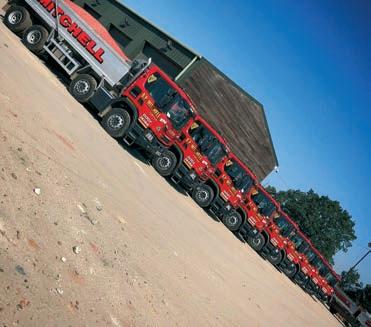
[ PARK MARK FREIGHT is a new and comprehensive assessment managed by Police Crime Prevention Initiatives and the British Parking Association that seeks to enhance the highest quality of today’s lorry parks and facilities in services and operations.
Park Mark Freight builds upon the Safer Parking Scheme’s existing Park Mark Award by introducing essential criteria for lorry parks. The Park Mark is primarily aimed at the prevention of criminal behaviour within the parking environment and requires owners/operators to adopt an active management strategy to ensure that there is minimal occurrence of crime. The freight industry experiences a high volume of cargo theft and the main Safer Parking Scheme Assessment Guidelines do not explicitly cover that type of business.
Facilities awarded the Park Mark Freight award are subject to an annual assessment to ensure the high standards required by the award are maintained. To be granted Park Mark Freight a parking facility must demonstrate a wide range of responsibilities, which includes low crime, measures in place to enhance the safety of people and vehicles, good management and operations, and exemplary customer service.
Sara Fisher, head of operations and business development at the British Parking Association, said: “There is an increased expectation
for efficient, well-managed and high-quality lorry parks and truck stop facilities in order to combat vehicle and cargo crime. We are delighted to launch Park Mark Freight with Police Crime Prevention Initiatives and look forward to awarding the Park Mark to facilities that can demonstrate the highest standards across their operations.”
To find Park Mark awarded car parks visit www.parkmark.co.uk. q
[ AN AGGREGATES SPECIALIST has reduced its insurance premium and successfully fought ‘crash for cash’ claims after upgrading its vehicle camera systems.
BP Mitchell Haulage Contractors Ltd is a leading provider of aggregates for the construction sector. It operates more than 60 trucks, predominantly tippers as well as 10 mixers and five articulated vehicles. The Hatfield-based company, which produces its own aggregates, holds FORS silver accreditation.

BP Mitchell is upgrading its camera systems from a six-channel to an eight-channel DVR system from Durite, which includes moving from smaller monitors in the cab to 9” monitors and fitting side detection kits. The company also installed driver-facing cameras as an additional measure to protect employees from false accusations.
Mick Howe, transport director at BP Mitchell, said: “Operating in London we have to comply with the Direct Vision Standard, so cameras are a must-have for us. However, we wanted a system that worked well for our drivers and enhanced safety as much as possible.
“The in-cab cameras are not a spying tool; they are for driver protection. We use them to prove the driver was operating the vehicle correctly.”
A key benefit of upgrading the camera systems has been a reduction in claims and lower insurance premiums: “As you can imagine with a relatively large fleet our insurance premiums were quite high,” added Mick.
“Thanks to the Durite cameras we have been able to fight crash-for-cash claims. Our premium went down this year by 5% which is not small beer. This was because our claims went down and a lot of that is due to the Durite camera systems.
“Our insurers have been so impressed that they actually gave us a payment towards fitting cameras, sensors and DVRs to five new vehicles. They know that the Durite system produces the right results in terms of proving it is not our drivers at fault when an incident occurs.”
BP Mitchell buys Scania truck chassis and builds bespoke tipper bodies onto them. When it ordered 23 new trucks this year, the company asked Durite to propose the best camera solution: “We have a great account manager at Durite and he worked with us to create a complete package,” said Mick. “He recommended what we needed and provided a complete solution comprising Durite products, right down to the cabling, relays and connectors – which made it really easy for us.
“We are rolling out 20 kits at the moment and will look to follow suit with the rest of the fleet. We have worked with Durite for several years and trust them to provide us with the best solution for our trucks. The new kits are excellent and the drivers like them as they are user-friendly. On top of that it makes my life much easier in terms of accident investigations.” q
• For more information about Durite visit the website at www.durite.co.uk
[ THIS YEAR sees the 50th anniversary of IFSEC, the leading security and fire safety exhibition. The show will take place at London’s ExCeL from 16-18 May.
In the words of the organisers, Informa Markets: “As the UK’s largest security event there’s no better place to maximise your ROI and meet thousands of global security professionals face-to-face.”

For exhibitors it’s an opportunity to ‘get ahead of your competition by positioning your brand and launching your latest products in front of your target audience’.
This year organisers expect around 23,000 visitors to 600 stands, attending seminars with over 60 speakers.
Alongside leading suppliers to the industry – such as Advancis, Dahua, CSL and more – there will be the opportunity to meet representatives from security associations such as BSIA, SSAIB, the Security Institute, ASIS, NSI, FSA and others. Networking opportunities include breakfast and drink receptions and closed-door roundtable discussions. The sectors represented include cloud security, surveillance, home security, smart buildings and much more.
Visitors can also explore how technology in the security industry has developed and adapted over the past few years. Unique demonstrations at the Converged Security Centre show how physical security and information technology combine to provide a holistic solution.
Said an Informa Markets spokesperson: “The security industry has seen ground-breaking innovation and product development over the last couple of years. Join an exclusive platform to explore the latest developments – some of which will be on display for the first time.”
One visitor to last year’s show enthused: "IFSEC might be the best exhibition to visit in terms of networking with the professionals in the field, due to its privileged location. Add to that the chance to observe the trends and novelties in the security field, and then a prospective visit becomes worthwhile.”
What’s more, IFSEC is co-located with four other shows, with one free ticket giving access to all of them.
• Discover solutions to combat safety risks in your workplace, benefit from in-show discounts and keep up to date with mental health initiatives at Europe’s best dedicated health and safety event, Safety & Health Expo.
• Prep for the future of the workplace and explore solutions for making them smarter, more efficient and more sustainable at Facilities Show.
• Hear about the use of technology in fire detection and the easily mismanaged policy of occupants staying put during a fire at the global centre of excellence for fire safety, FIREX.
• Experience a unique, fullyequipped, life-size smart building
environment and see how the most innovative and interactive technology can bring together facilities management, security, fire safety and wellbeing in one place at Intelligent Building Europe.
To register your interest visit www.ifsecglobal.com q

[
TILBURY DOUGLAS has been appointed to lead the construction of St Mary’s Catholic Voluntary Academy, which will be the UK’s first purposebuilt biophilic primary school. The contract is part of a pilot scheme for the Department for Education (DfE).

The new school, which is part of St Ralph Sherwin Catholic Multi Academy Trust, will replace the original school, which was destroyed by fire in October 2020.
Biophilia is an approach that focuses on connecting those inside a building with nature and increasing biodiversity through design. The new building will be net zero carbon in operation.
The new school, which will comprise five single-storey buildings connected by covered walkways, will be predominantly constructed from low-carbon timber, employing structurally insulated panels and modern methods of construction.
With mechanical and electrical engineering being delivered by Tilbury Douglas Engineering, the new school will have a natural ventilation strategy and air source heat pumps alongside renewable energy, such as photo voltaic (PV) solar panels. Besides PV, some of the roofs will be green wildflower seeded to maximise biodiversity and local ecology.
Simon Butler, managing director of building central at Tilbury Douglas,
said: “We are proud to be the main contractor responsible for delivering this innovative pilot scheme for the DfE, as it will enhance pupil experience and influence the next generation of school design.
“We are working collaboratively to ensure the best possible learning environments are afforded for the pupils and teachers, with excellent standards of daylight, air quality, comfort and wellbeing. This is supported by the biophilic approach, focusing on landscaping and connecting building users with outside.” q
[
THE UK GREEN BUILDING COUNCIL (UKGBC) has expressed its support for the recommendations of the report by Parliament’s cross-party Environmental Audit Committee (EAC), which calls for a national ‘war effort’ on energy efficiency.

The UKGBC’s director of communications, policy and places, Simon McWhirter, said: “As we close the book on the warmest year on record in the UK, with millions of people across the country still struggling to afford to heat their homes, the EAC is right to call for a national mobilisation on energy efficiency. We cannot afford any more winters like this one.
“Between the EAC’s report and our own analysis, it is clear that the government urgently needs to improve both its clarity and ambition on decarbonising the built environment if we are to meet our net zero commitment.
“Moving to a war effort means drawing on all the government’s powers to solve this national challenge. We welcome the EAC’s target of 2.5 million annual efficiency installations by the end of the decade, and we urge the government to consider UKGBC’s recommendations, such as incentivising energy performance through the tax system and mortgage market and setting new standards to guarantee new build homes are net zero carbon.
“Like any war effort, making the right choices can save lives: energy efficiency can prevent a range of illnesses and conditions to save the NHS £1.4bn and 10,000 lives a year.
“The UK building industry can and will meet the challenge, but only if government commits to the long-term policies, training and investments that our members and their workforces urgently need to deliver on this national mobilisation.” q











